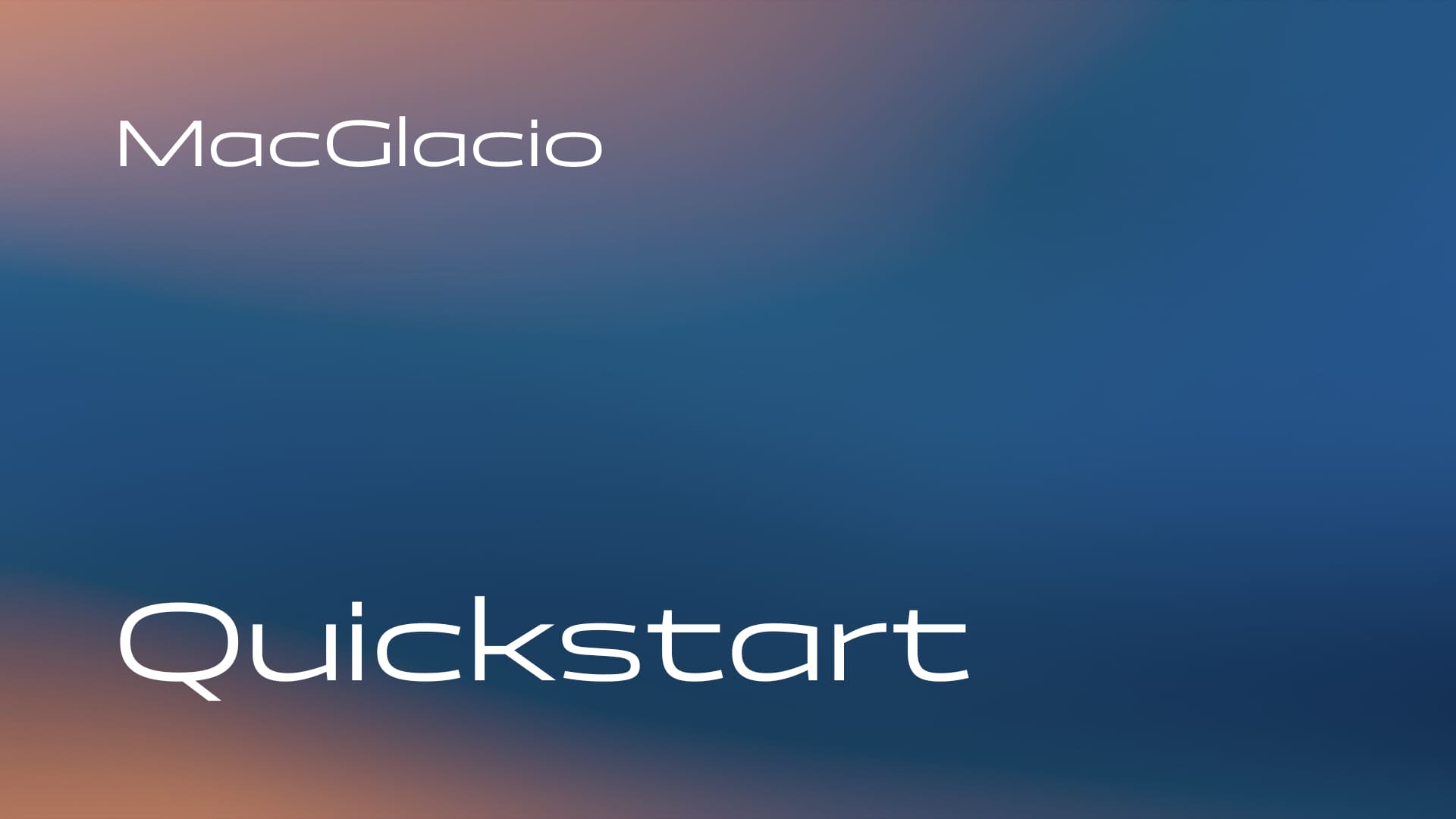After reading this Quick Start Guide, you'll be familiar with all the features, settings, and operation modes of MacGlacio.
If you're new to MacGlacio, we recommend reading the guide from start to finish to gain a complete understanding of how to use it.
› Using MacGlacio for the First Time
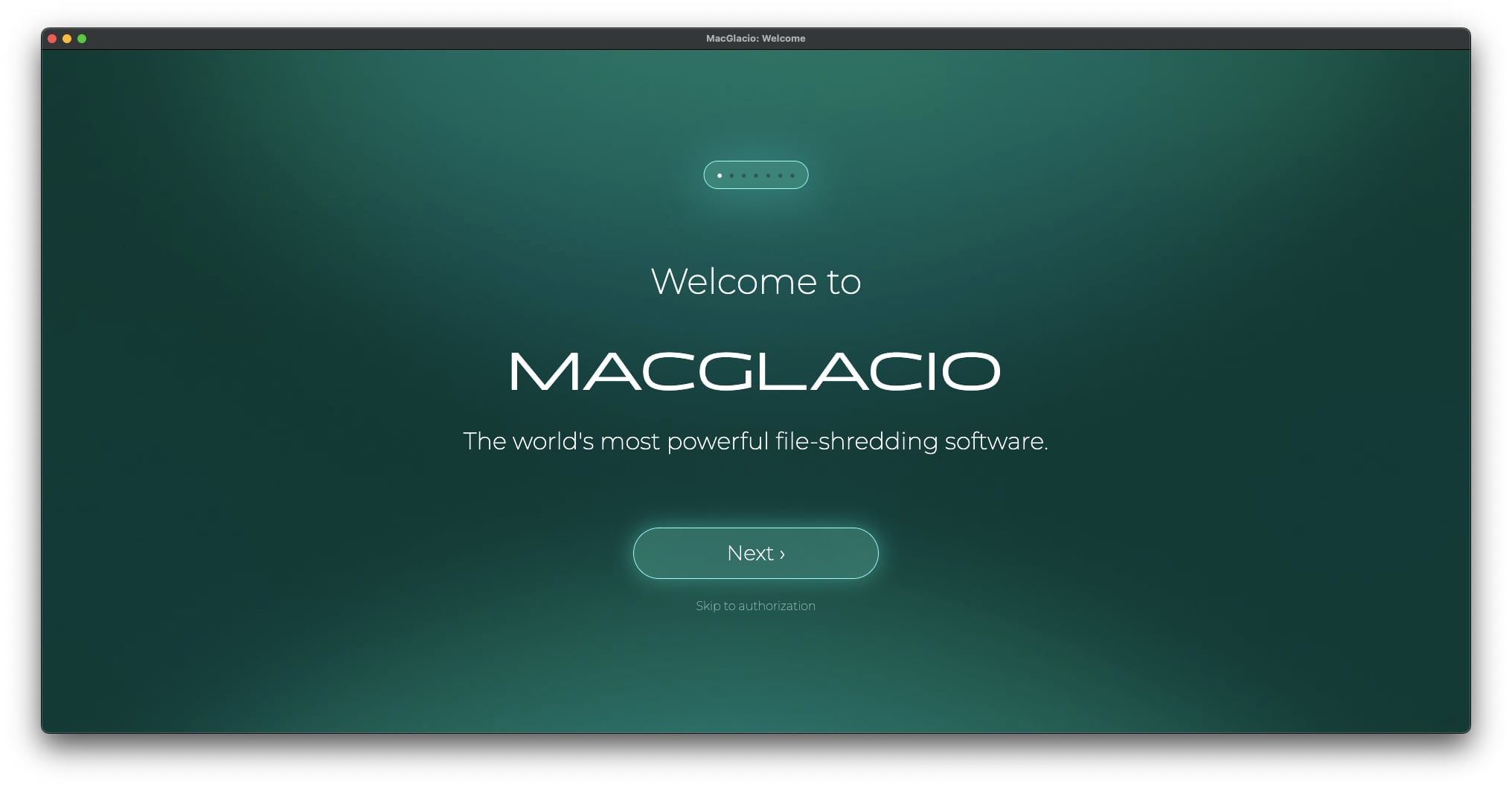
When you open MacGlacio for the first time, you'll be greeted with seven welcome pages that explain what MacGlacio does and how it can be useful in different scenarios.
You can navigate through the pages using:
- The "Next" button (at the bottom of each page) or the "Back" button (indicated by the arrow symbol "←" in the top-left corner).
- The "Esc" or "Return" ("Enter") keyboard keys (when available).
- The small white circles at the top of the program (when available).
If you'd like to skip the introduction and go directly to the "Authorization" page, where you can enter your Ambeteco account details and start using MacGlacio, simply click the "Skip to Authorization" button at the bottom of the window.
› Authorization
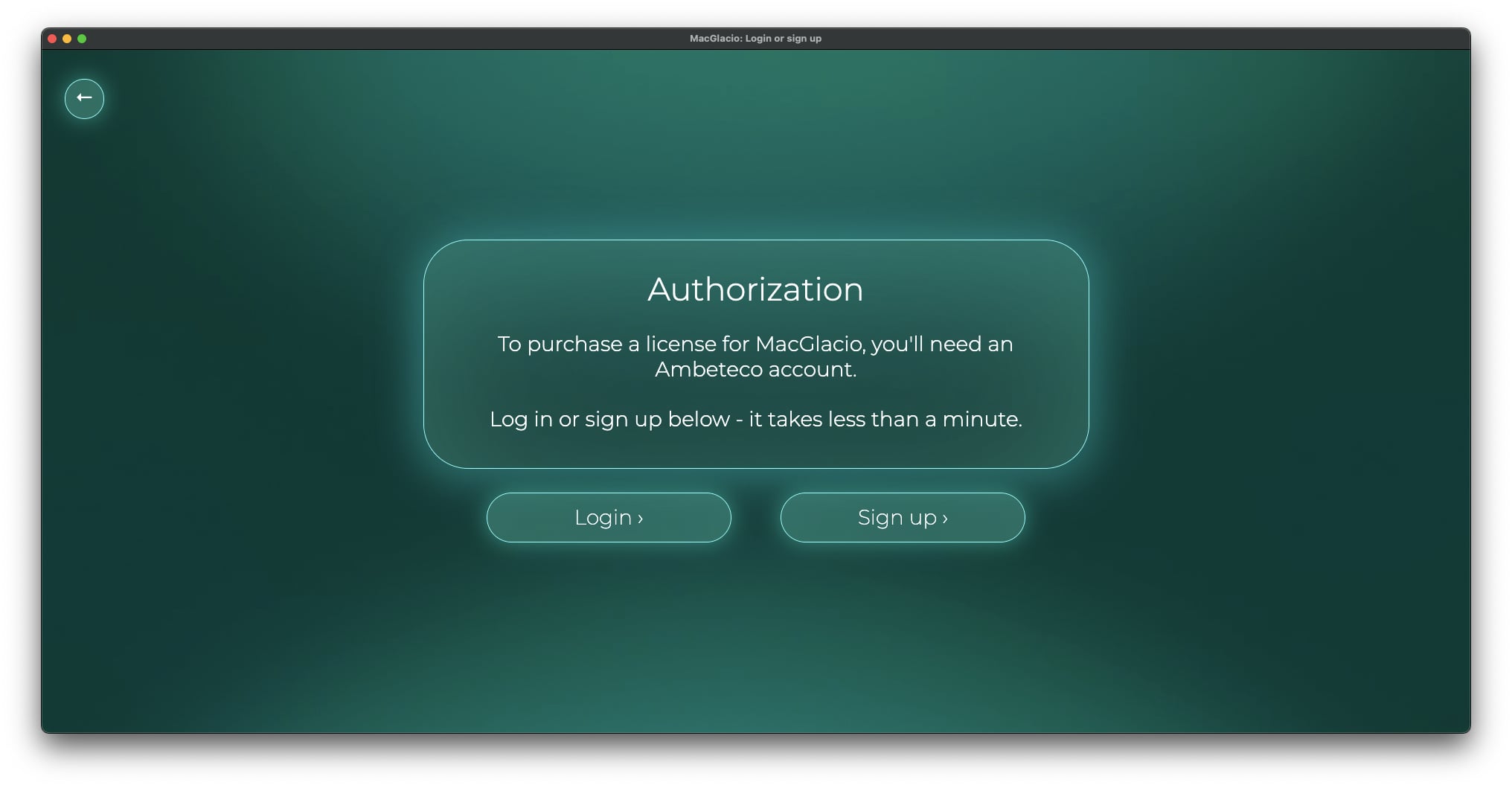
To use MacGlacio, you’ll need an Ambeteco account. Instead of relying on outdated license keys, we've introduced an account-based login system, so one Ambeteco account gives you access to all our software.
On the "Authorization" page, you can either log in to your existing account or create a new one using the respective buttons.
You only need to log in or register once, as MacGlacio uses a secure authentication algorithm to store your account information, eliminating the need to authenticate every time.
› Login
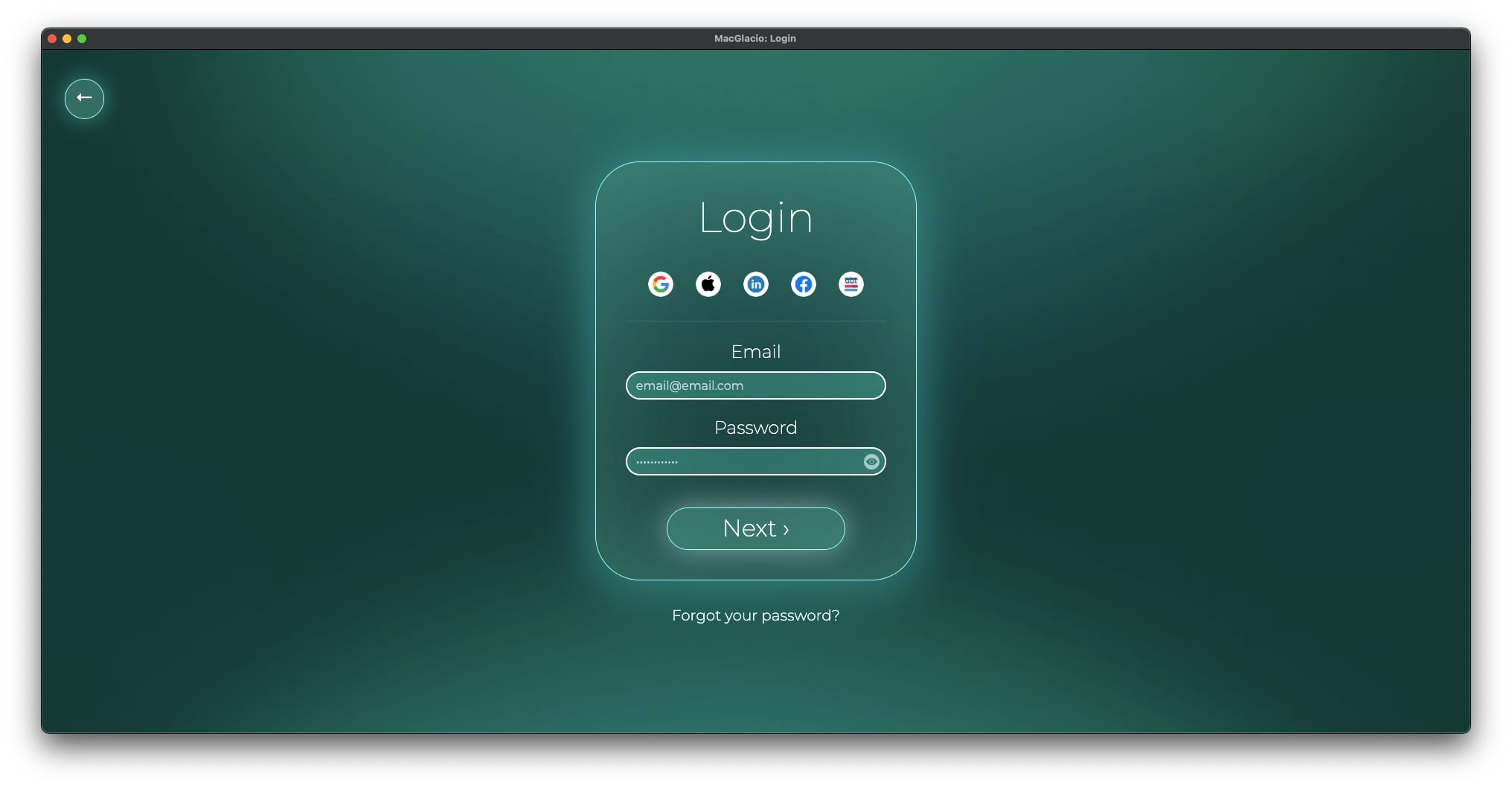
If you already have an Ambeteco account, simply log in using your email and password. You can click the eye icon to show or hide your password.
Alternatively, you can quickly log in using your social media accounts or Ambeteco Connect. Google, Apple, Facebook, and LinkedIn are supported for quick login, while the Ambeteco logo will open Ambeteco Connect.
› Sign Up
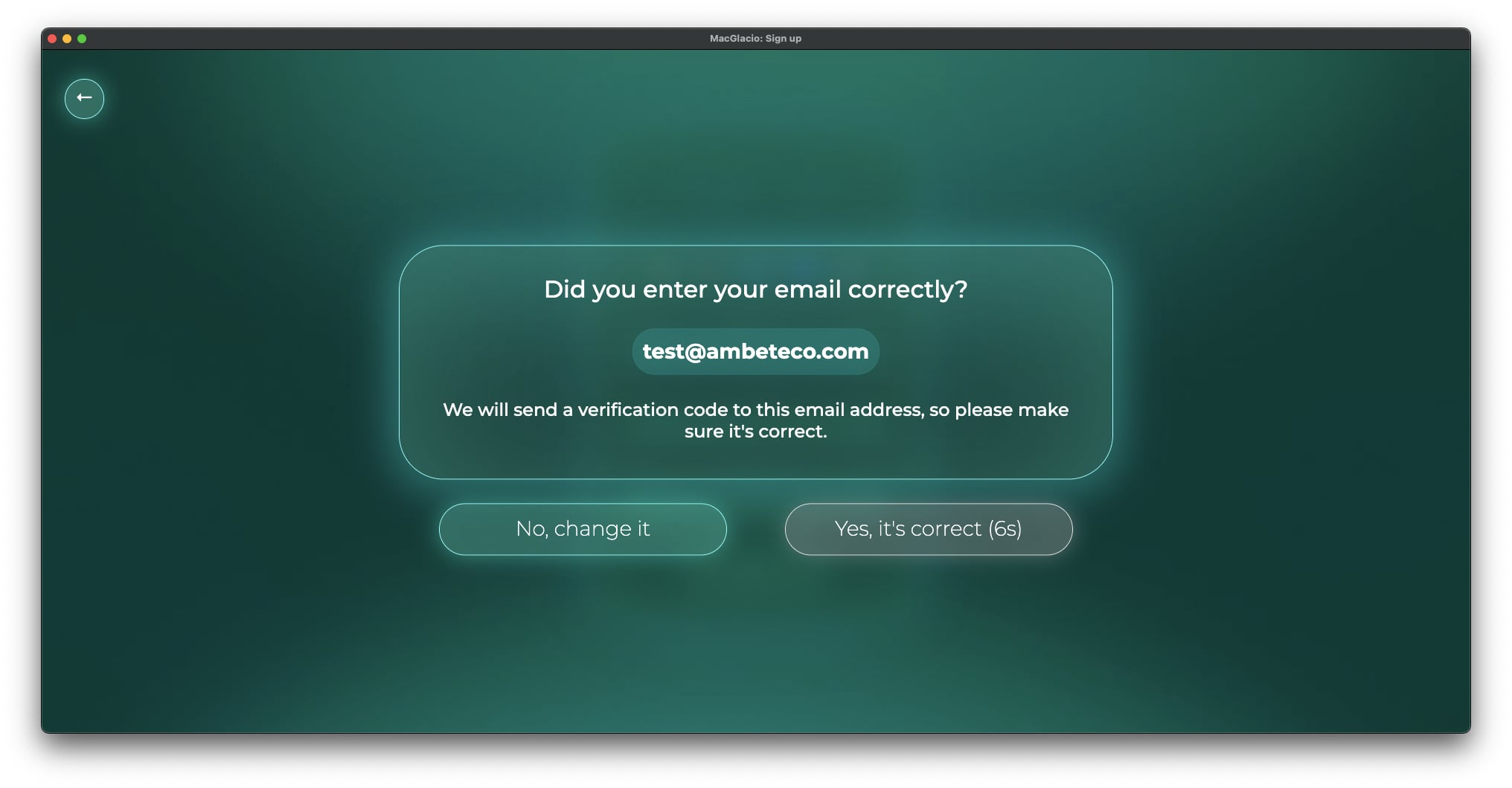

Creating an account is simple: just enter your name, email, and password to register. We’ll send a verification code to the email you provided. Once you enter the code, your Ambeteco account will be activated, and you can start using it immediately.
Alternatively, you can quickly sign up using your social media accounts by clicking the respective buttons (Google, Apple, LinkedIn, Facebook).
› Ambeteco Connect
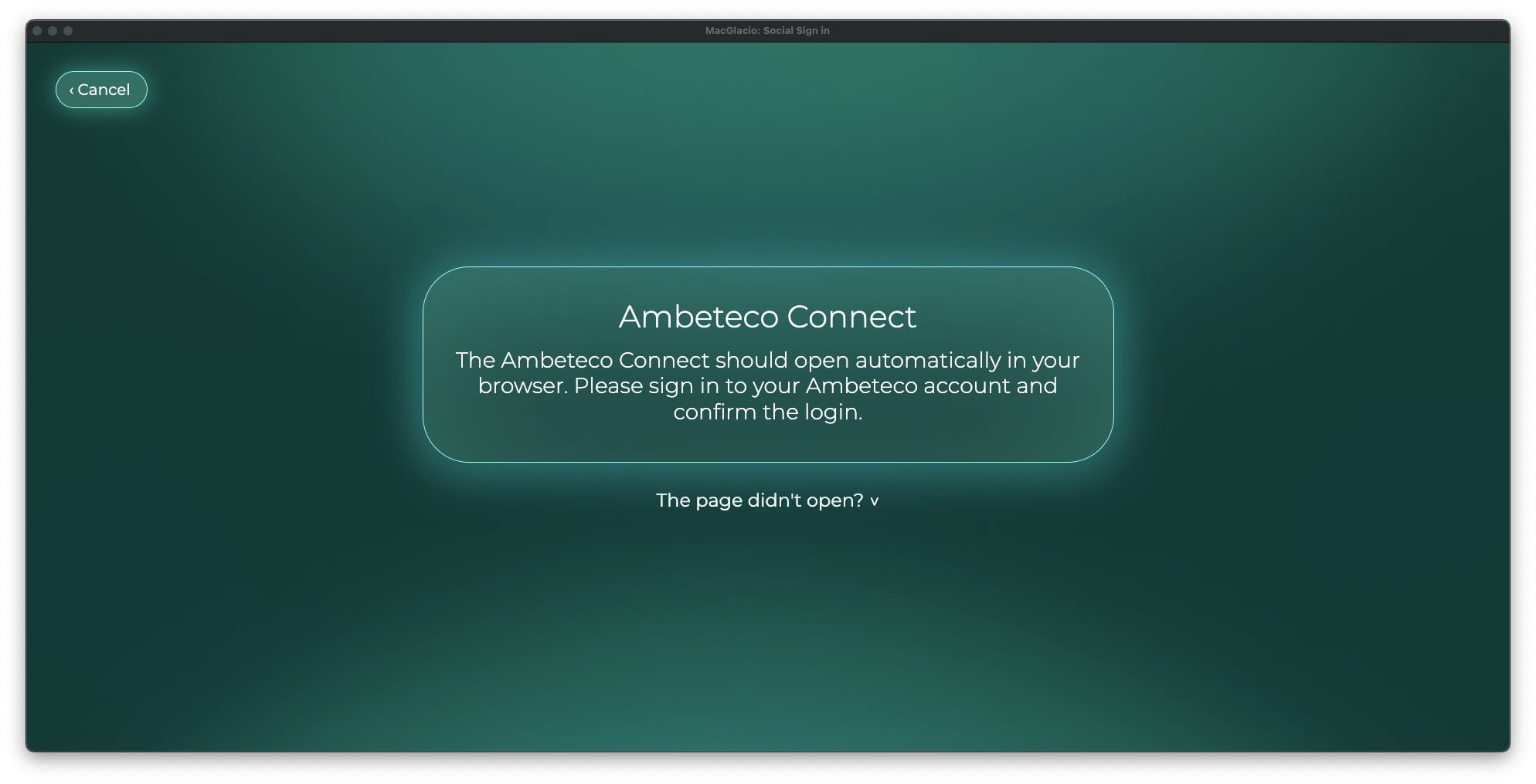
This window will appear after you press any social login button.
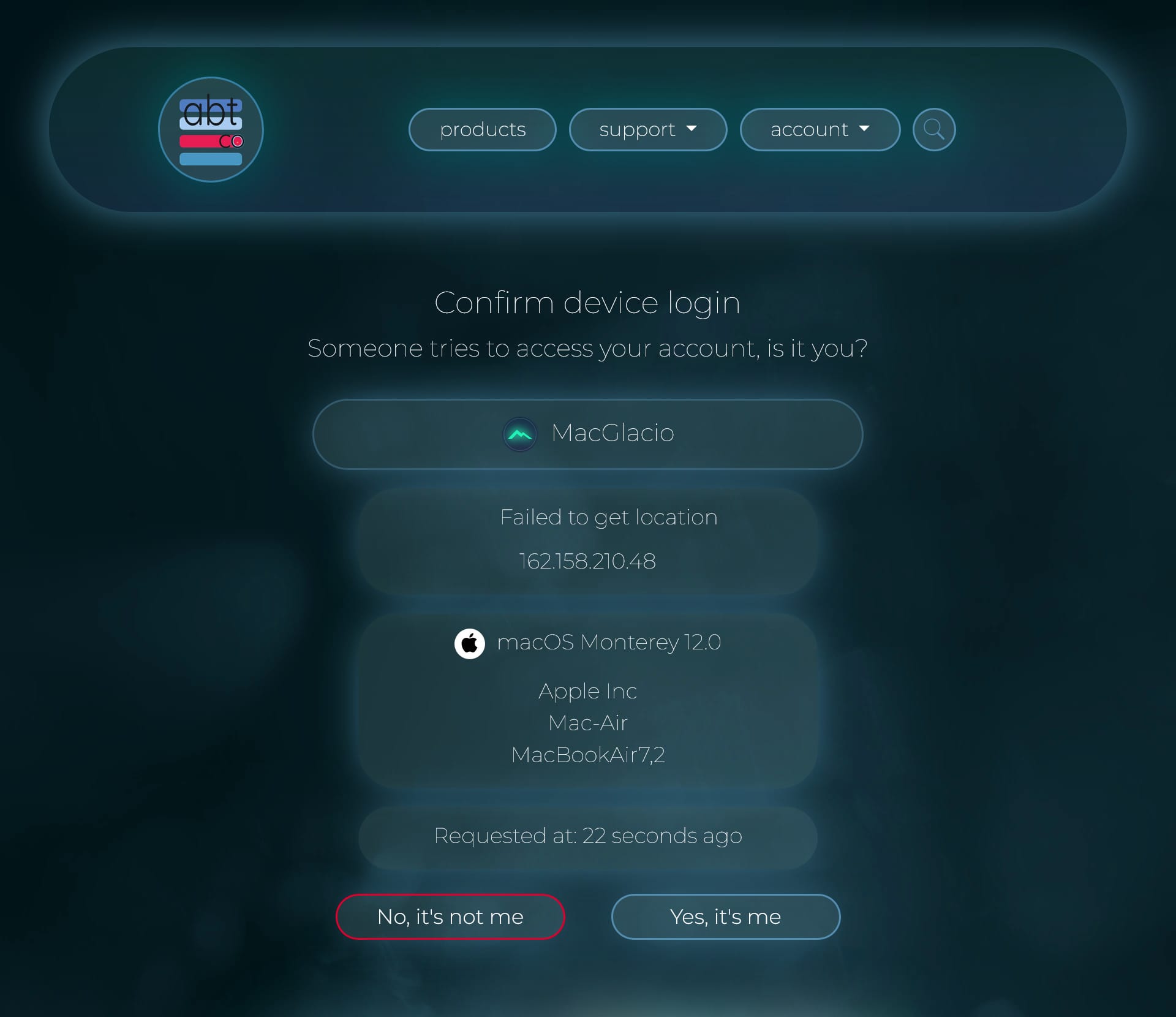
The Ambeteco website will open, and you will be asked to confirm the authentication.
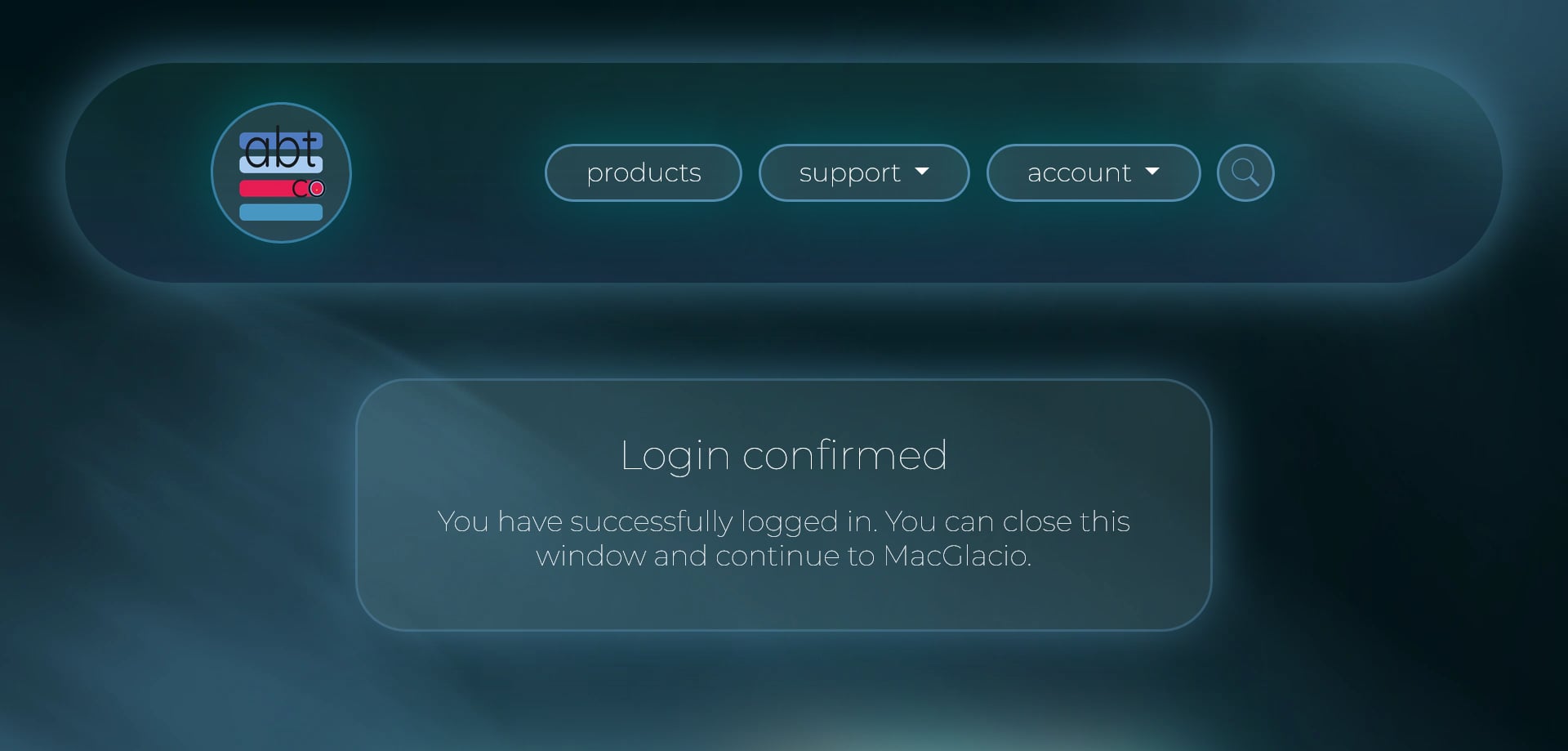
After confirming the connection, you can simply close the page.
Ambeteco Connect is a quick and secure authentication method that allows you to easily authenticate your account with just one click. It allows you to synchronize your account from our website to any Ambeteco software. When you click on the social media login or signup buttons, Ambeteco Connect will automatically attempt to authorize your account, eliminating the need for manual login.
Here's how to use Ambeteco Connect:
- Click any social media button in the "Sign up" or "Login" window.
- Your browser will open, taking you to the Ambeteco Connect page.
- If you're not logged into your Ambeteco account, or if you don't have one, you can register or log in on this page.
- Once authenticated, a new page will appear asking you to confirm the connection request. You’ll be able to review the request and choose to confirm or deny it.
- After confirming the request, MacGlacio will automatically sync your account.
› Select a License
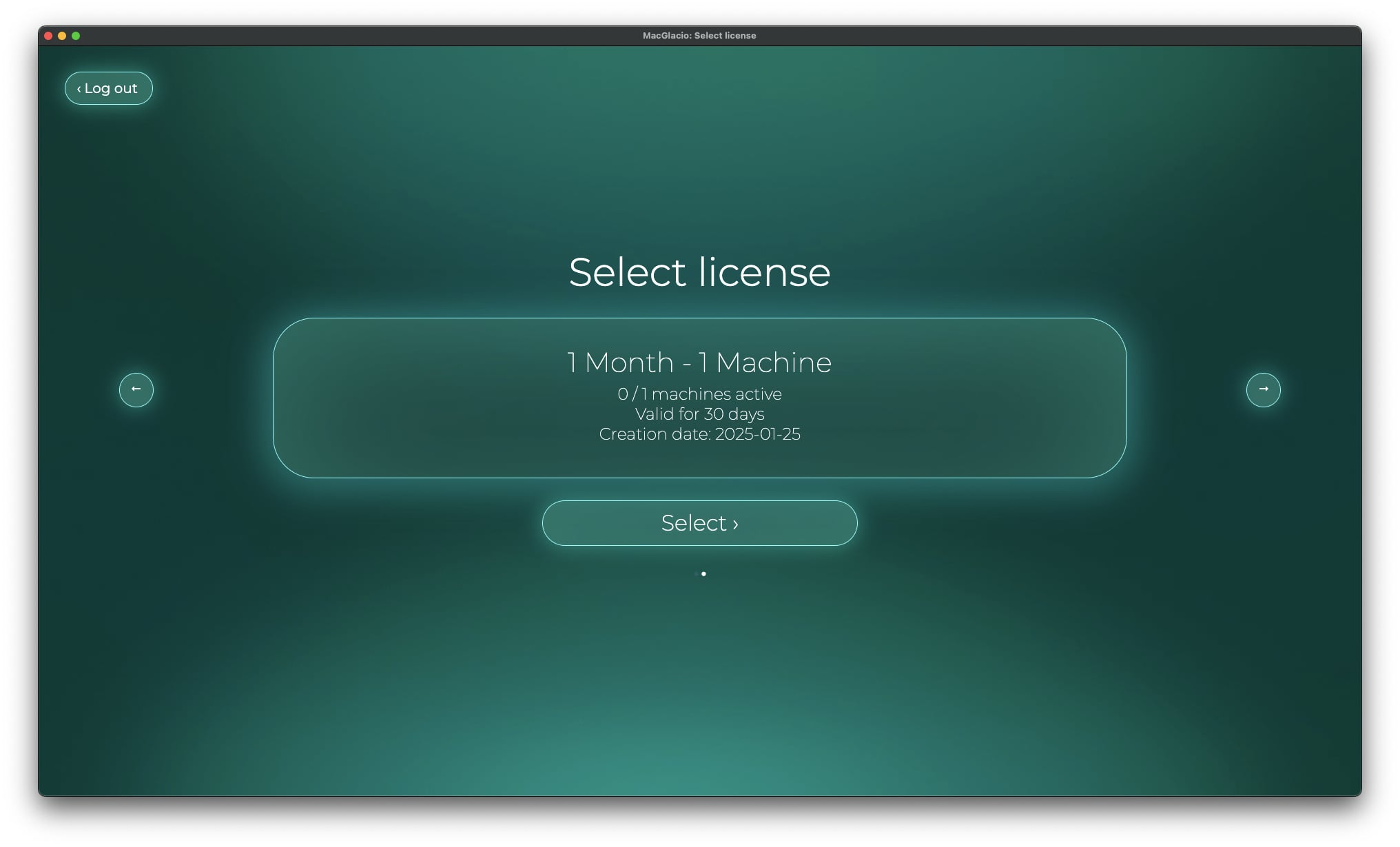
If your account has only one license for MacGlacio, the main page will open automatically, and you can start using the program immediately. If you have more than one license for MacGlacio, you will need to select the license you want to use by clicking on the arrows located on the left and right sides of the window and then clicking on the "Select" button at the bottom.
› Pricing
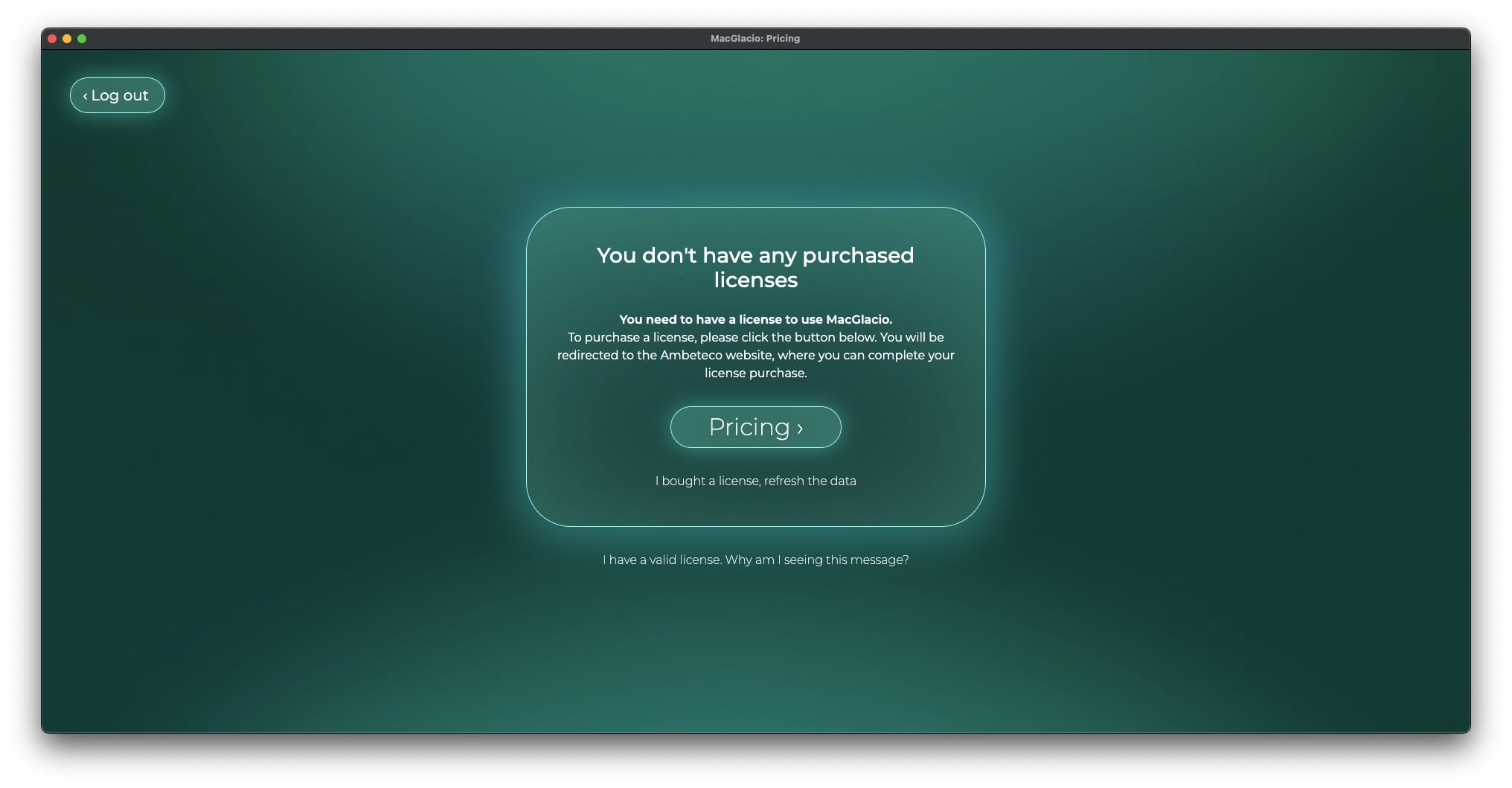
If you don’t have a license for MacGlacio yet, the "Pricing" window will appear, directing you to Ambeteco's website to purchase a license. After purchasing, simply click the "I bought a license, update the data" button. MacGlacio will update its data and take you to the main window.
› Setup Tour
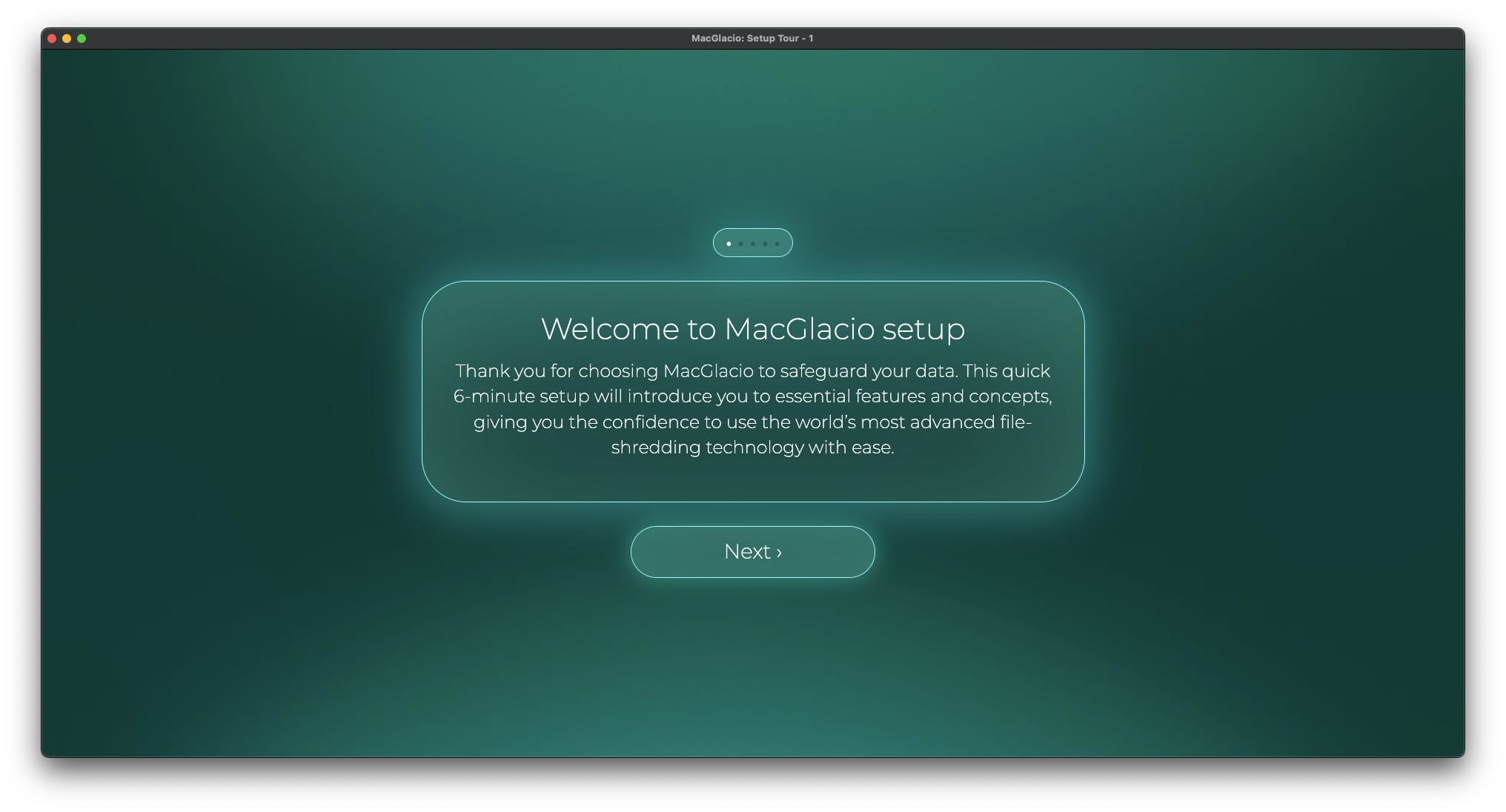
If you have never used MacGlacio before, a setup tour will appear where you will be able to personalize the program and learn how to use it.
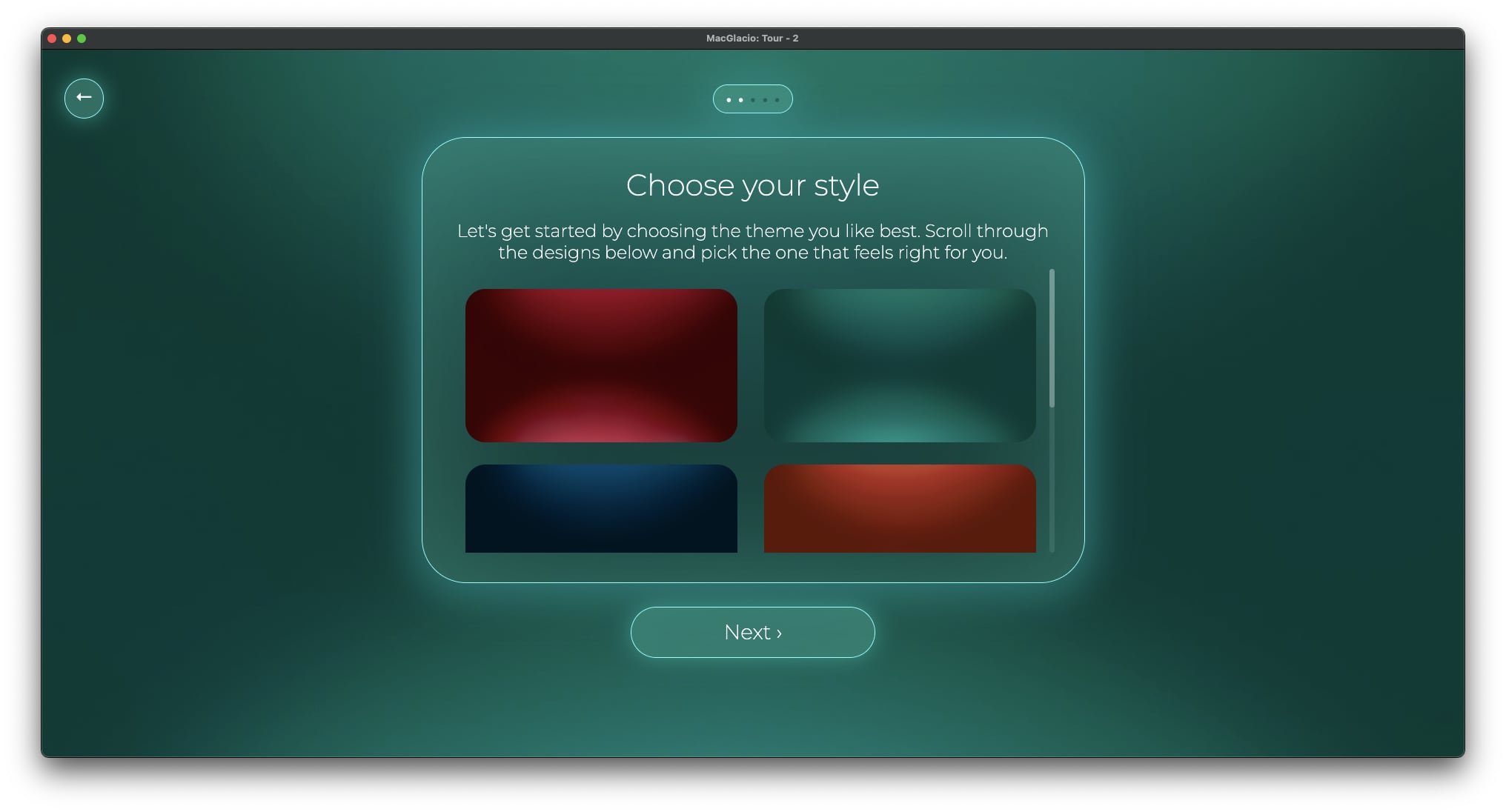
Selecting the theme. Six themes are available.
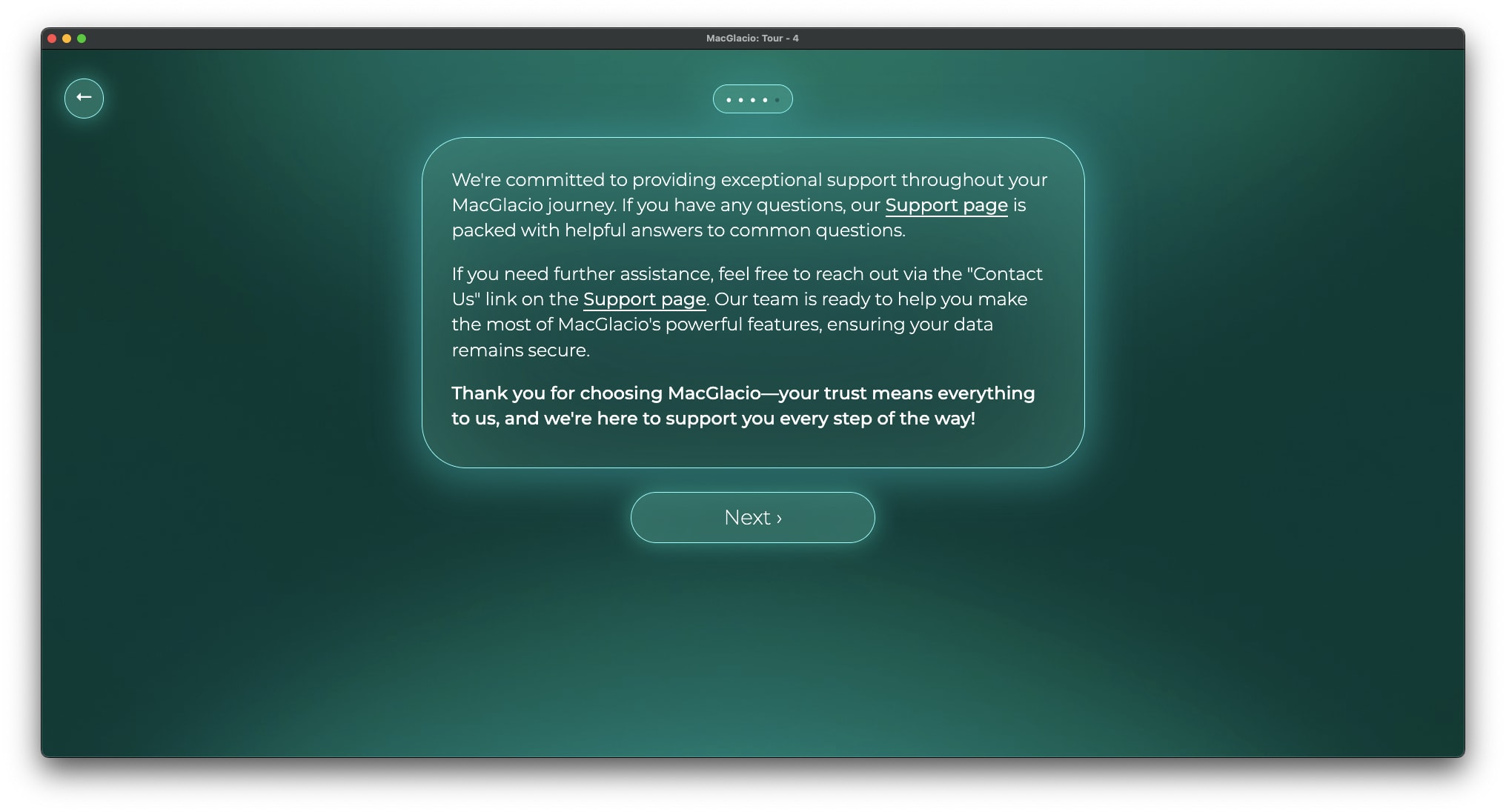
Information about technical support.
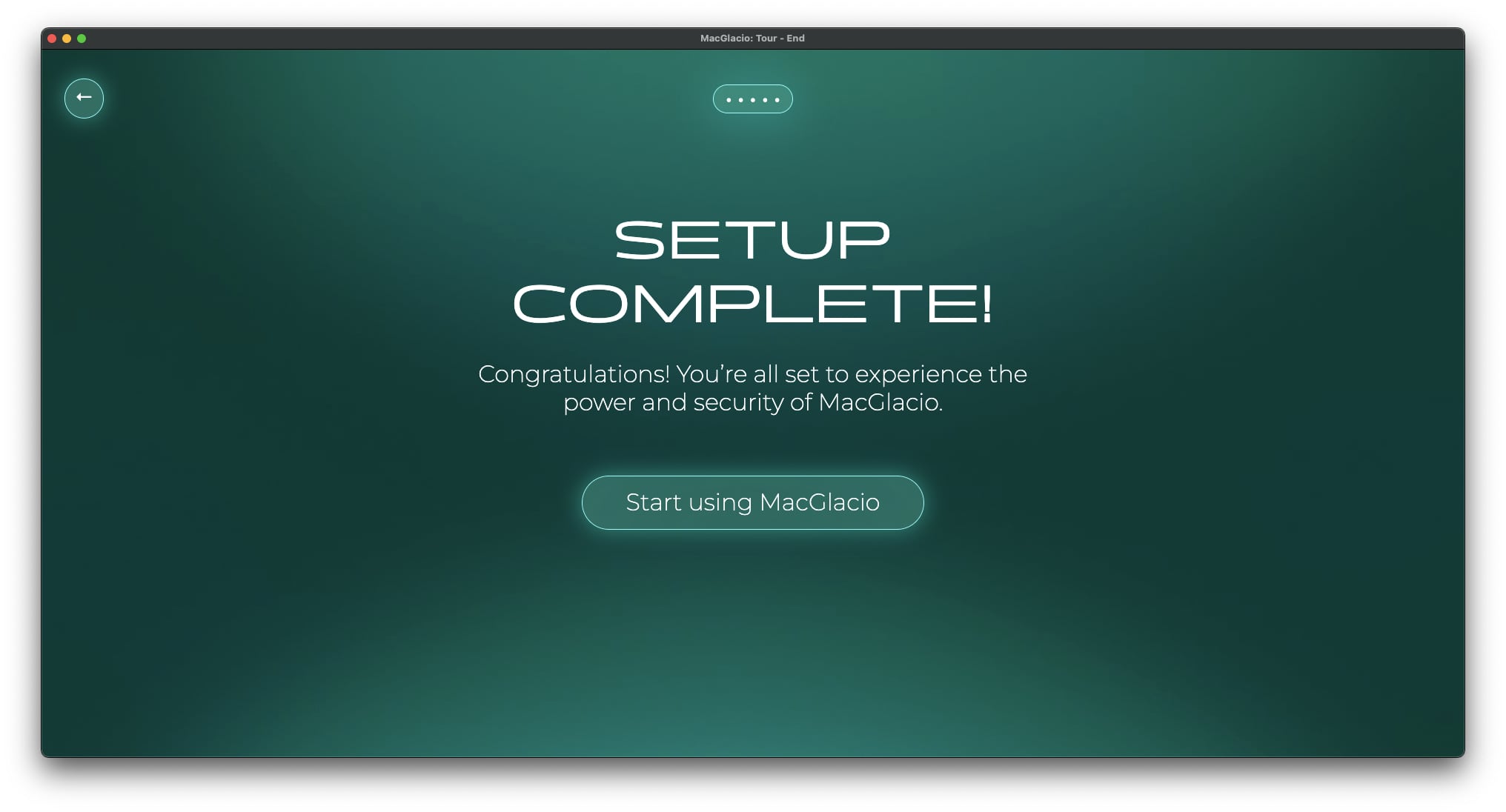
After completing the Setup Tour, click the "Start using MacGlacio" button to finish it.
› Main Window
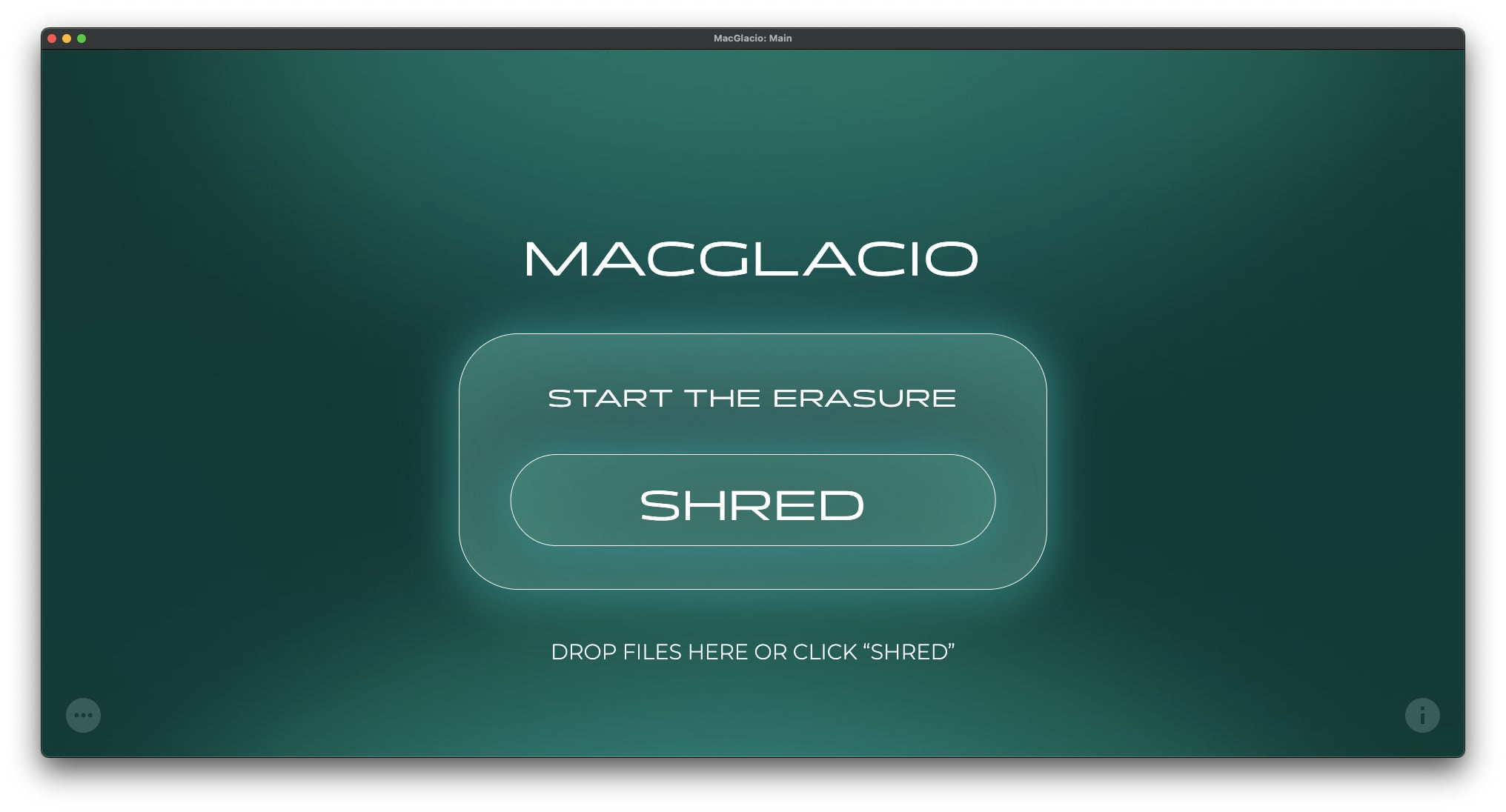
The main window of MacGlacio is the first screen you'll see when you open the program. It's the central hub where you can access all functions and settings.
Here’s a quick overview of the buttons in this window:
- "Start the erasure" block (center of the screen): Click here to begin shredding files.
- "Menu" icon (lower-left corner, shown in the image below): This pop-up menu lets you navigate to other MacGlacio windows, adjust settings, change the interface theme, shred the Trash, or view the "License Information" window.
- "About" icon (lower-right corner): Click here to open the "About" window for more details about the program.
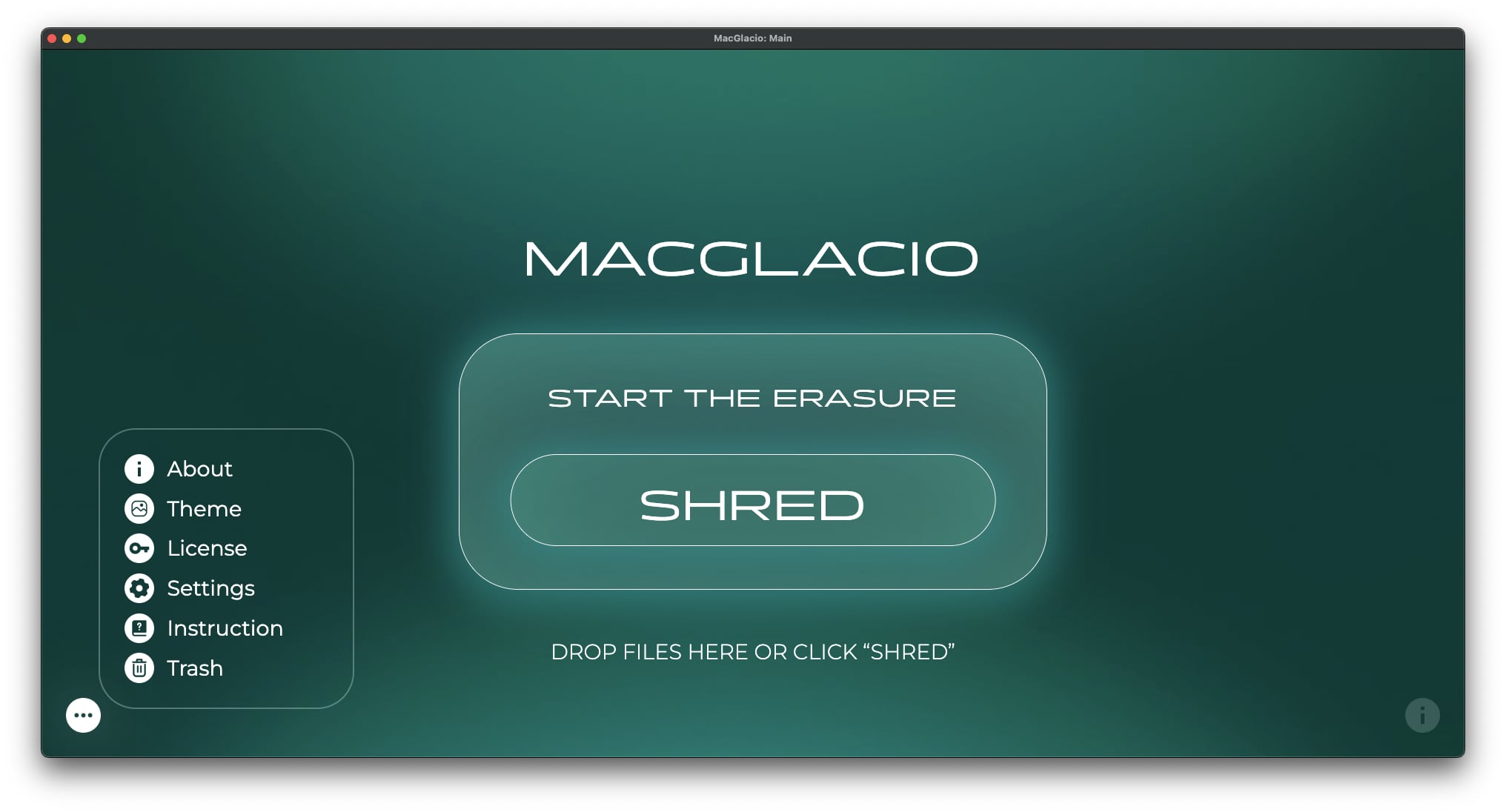
› Shredding files and folders
Shredding files is easy with MacGlacio. Simply click on the "Start the erasure" block to open the Configure Shredding window. From there, you can drag and drop files or folders onto it, or click to open files via the Finder "Browse" dialog.

From the Main window, click on the "Start the erasure" block. This will open the Shredding Configuration window.
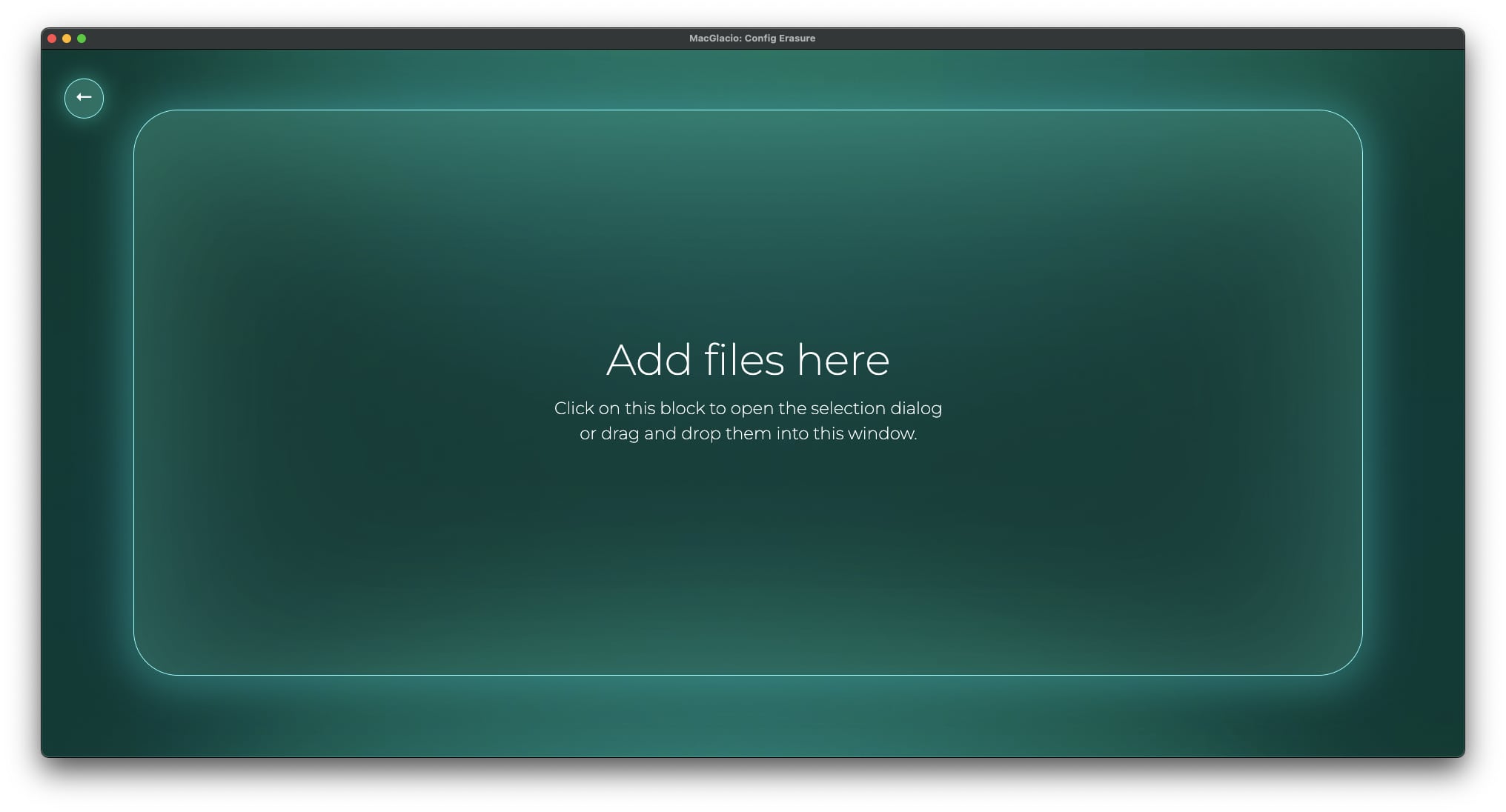
There are two ways to add files/folders for shredding: by drag and dropping, or by using the Finder dialog.
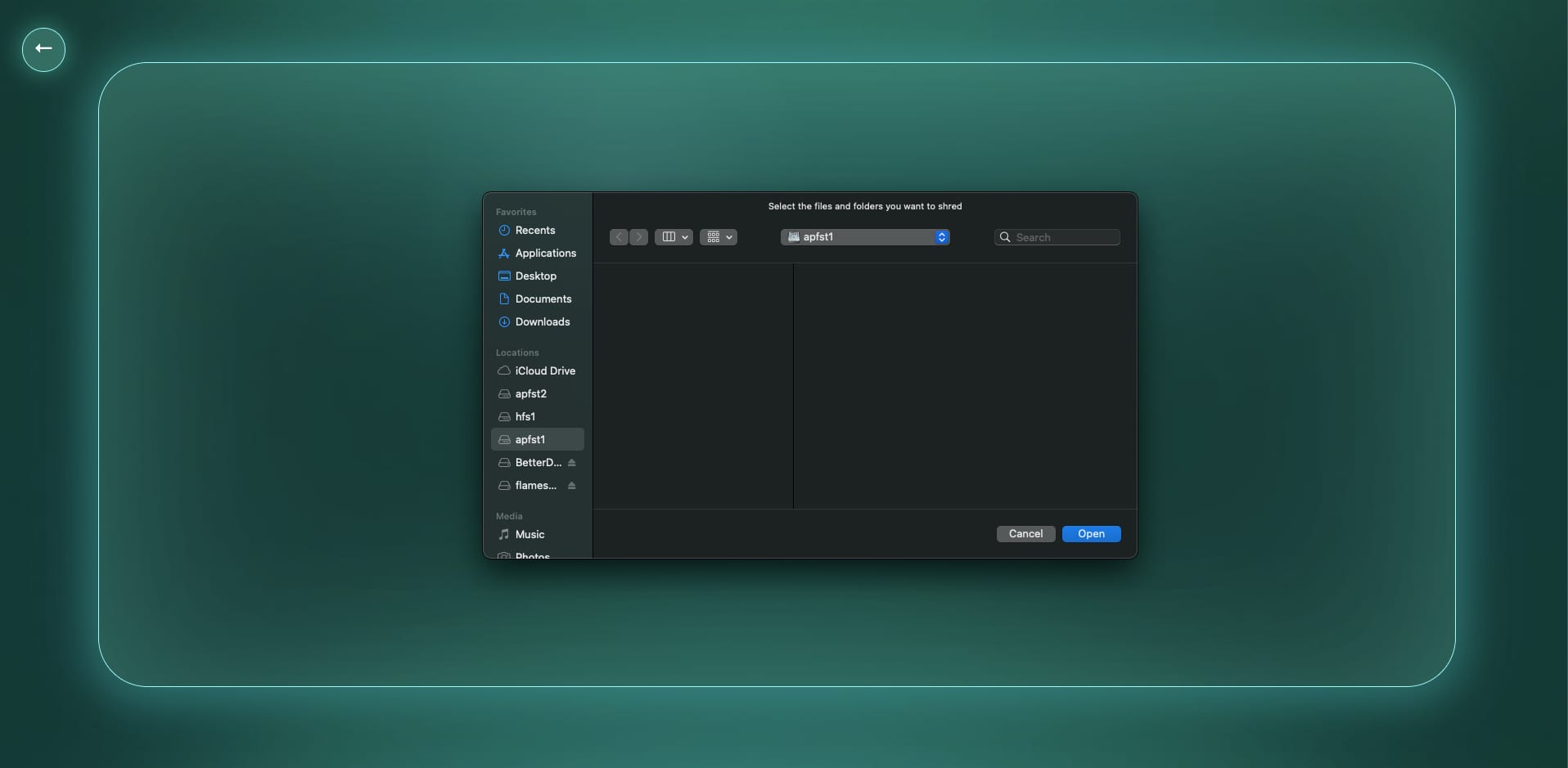
Option 1: Click to add files via the Finder "Open" dialog.
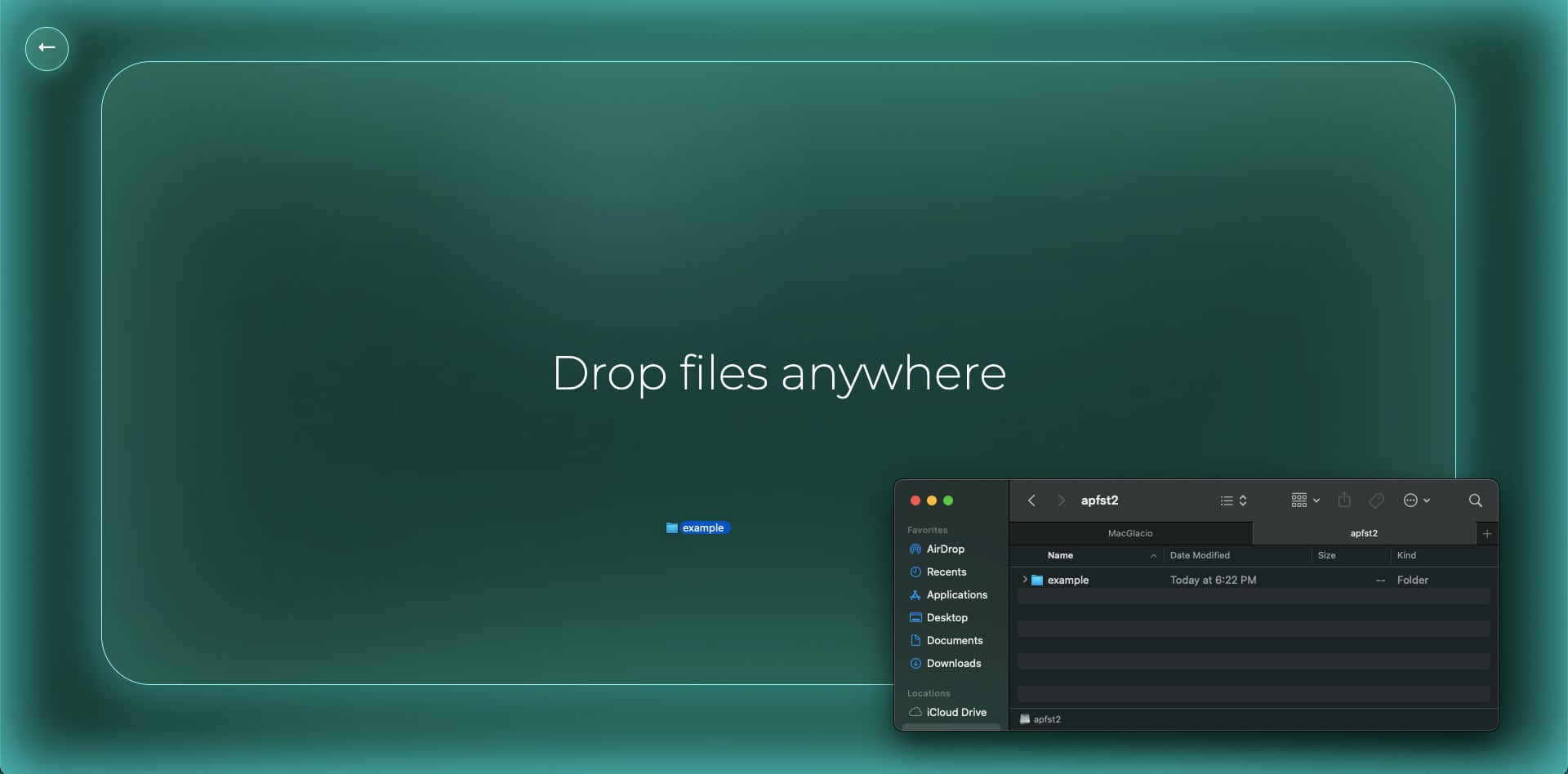
Option 2: Drag and drop the files you wish to shred onto the window.
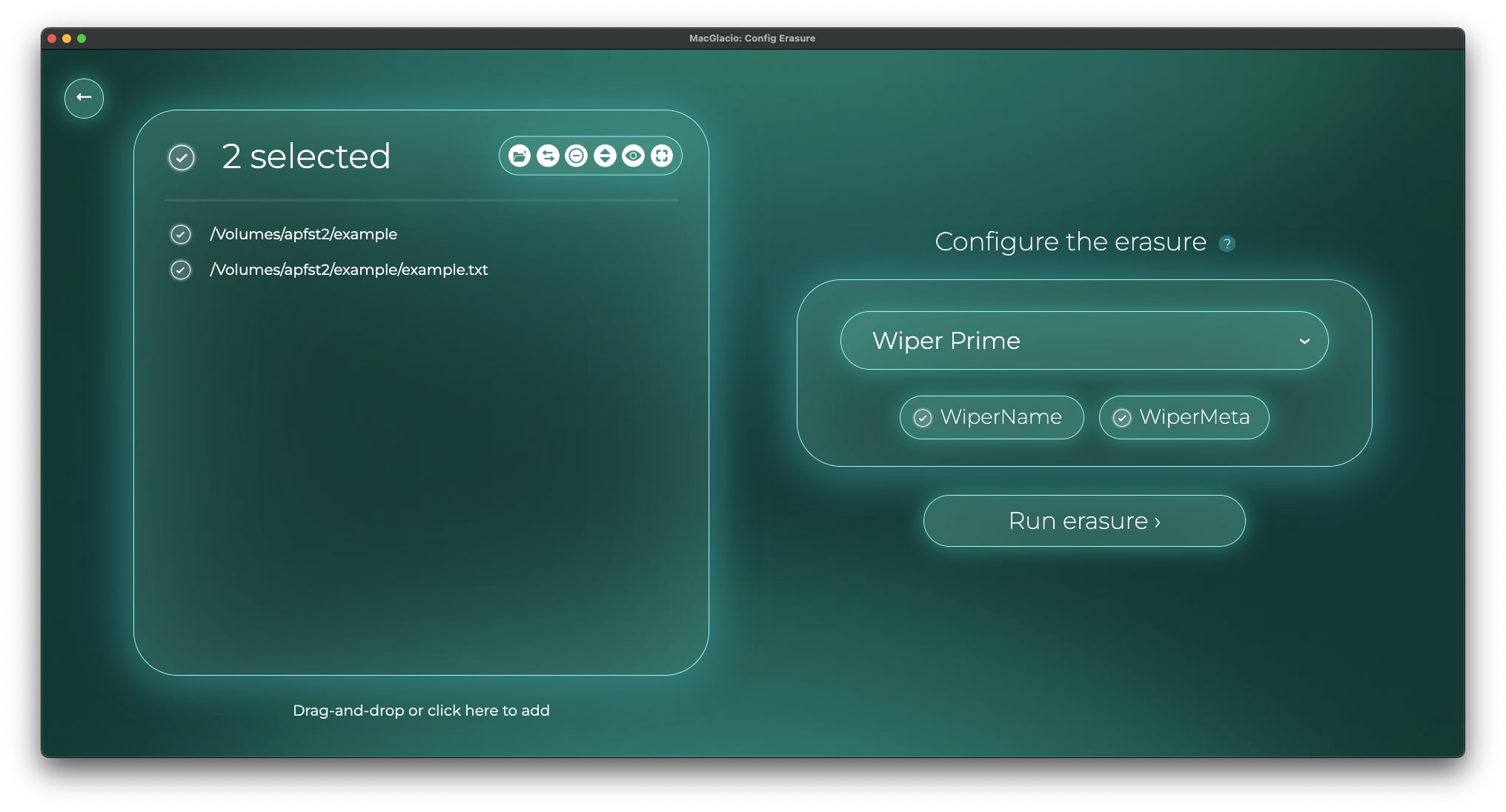
Done! MacGlacio will open the "Shredding Configuration" window, displaying the files and folders you added. After adjusting the shredding settings, you can begin the erasure process.
Alternatively, one of the easiest and most convenient ways to shred files or folders is to simply drag and drop them onto the MacGlacio Main window.
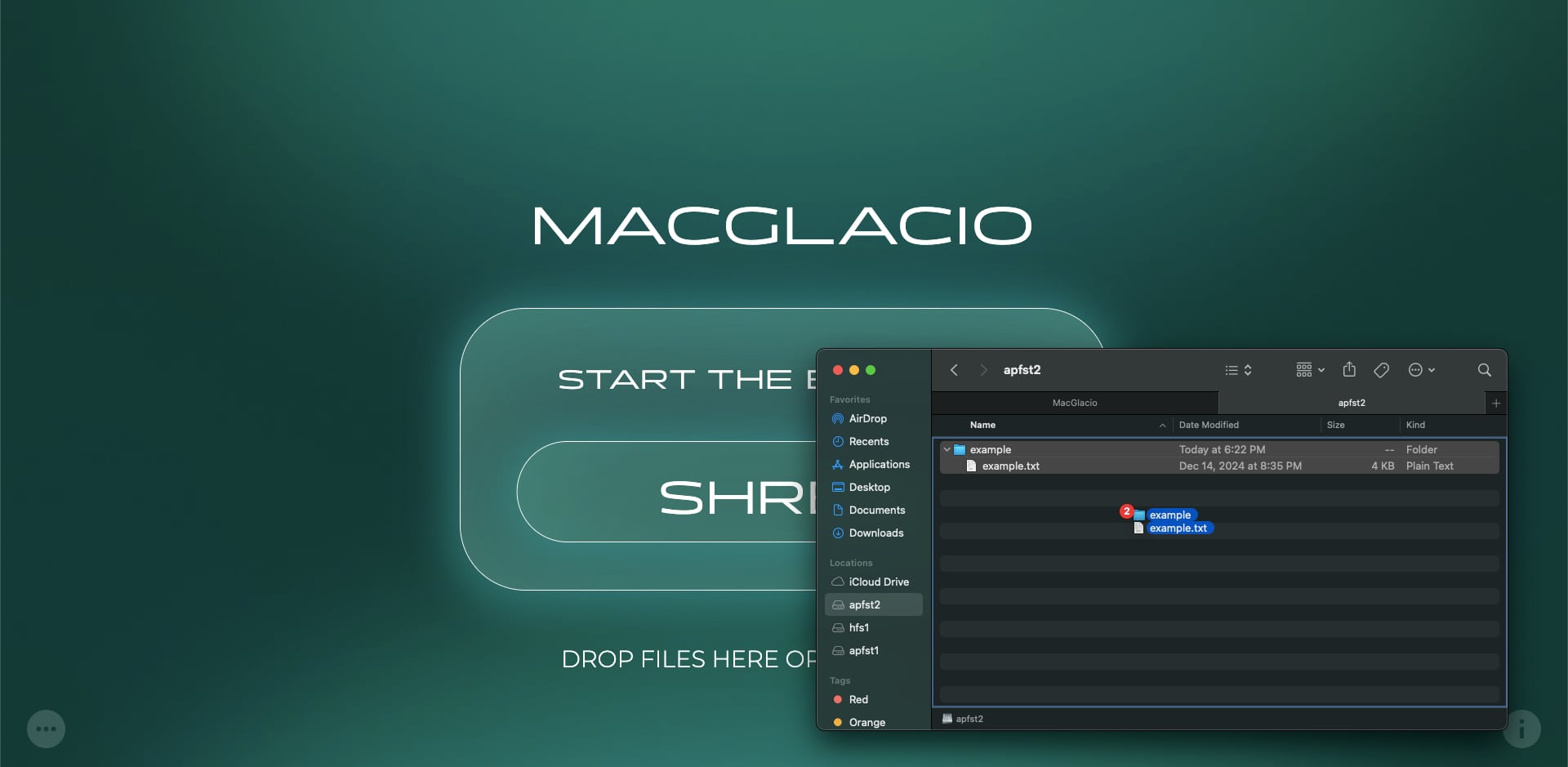
Select any files or folders you wish to shred in Finder.
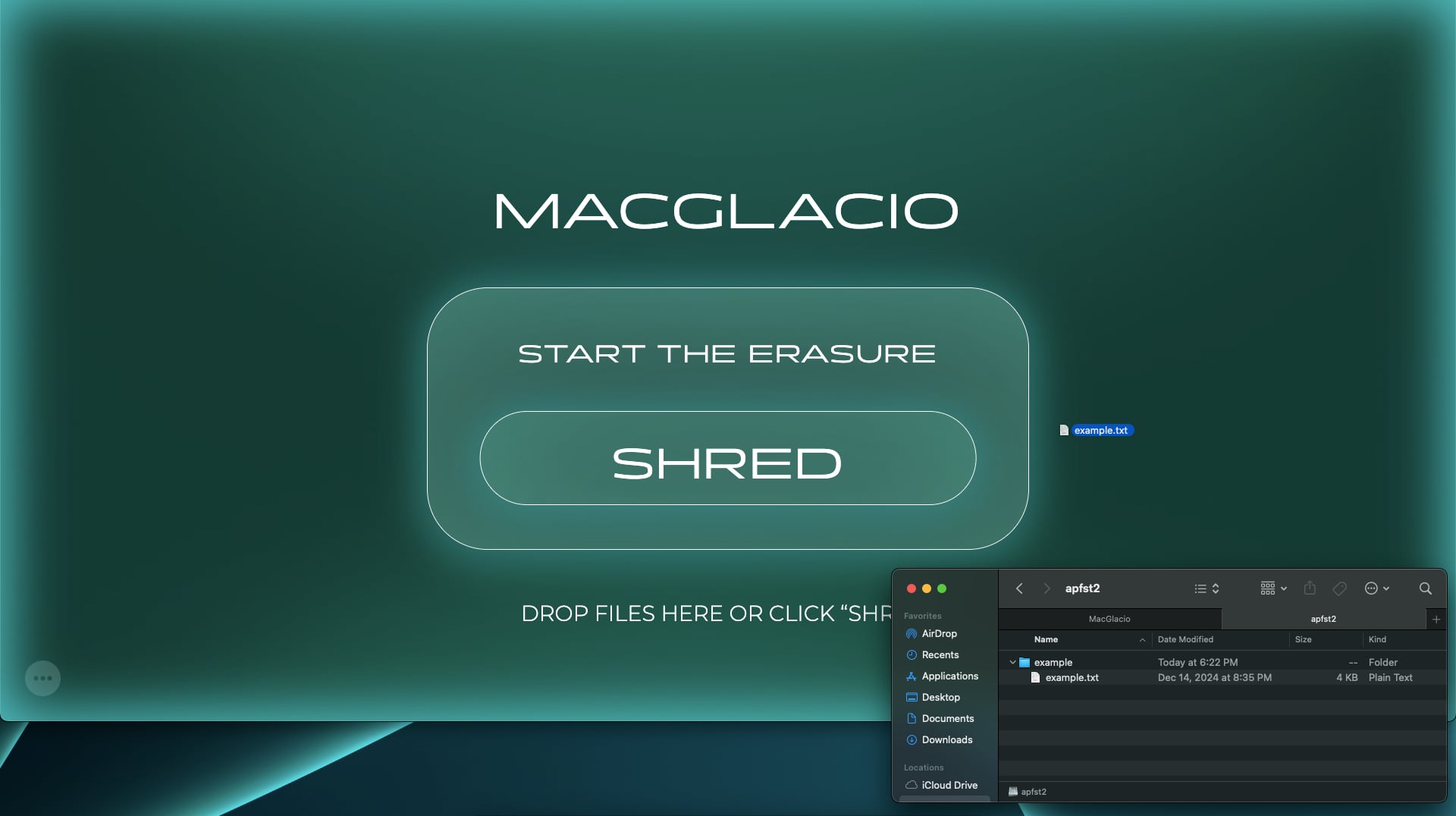
Drag and drop them onto MacGlacio's Main window.

Done! MacGlacio will open the 'Shredding Configuration' window, where you can view the files and folders you’ve dragged and dropped. After configuring the shredding settings, you can start the erasure.
The window you're currently viewing—the Shredding Configuration window—lets you add or remove files and folders to be shredded, as well as configure the shredding process. You can adjust the erasure algorithm and toggle the WiperName and WiperMeta technologies. This window is split into two sections. On the left, you'll see a list of the files and folders you've selected for shredding. Everything in this list will be permanently erased.
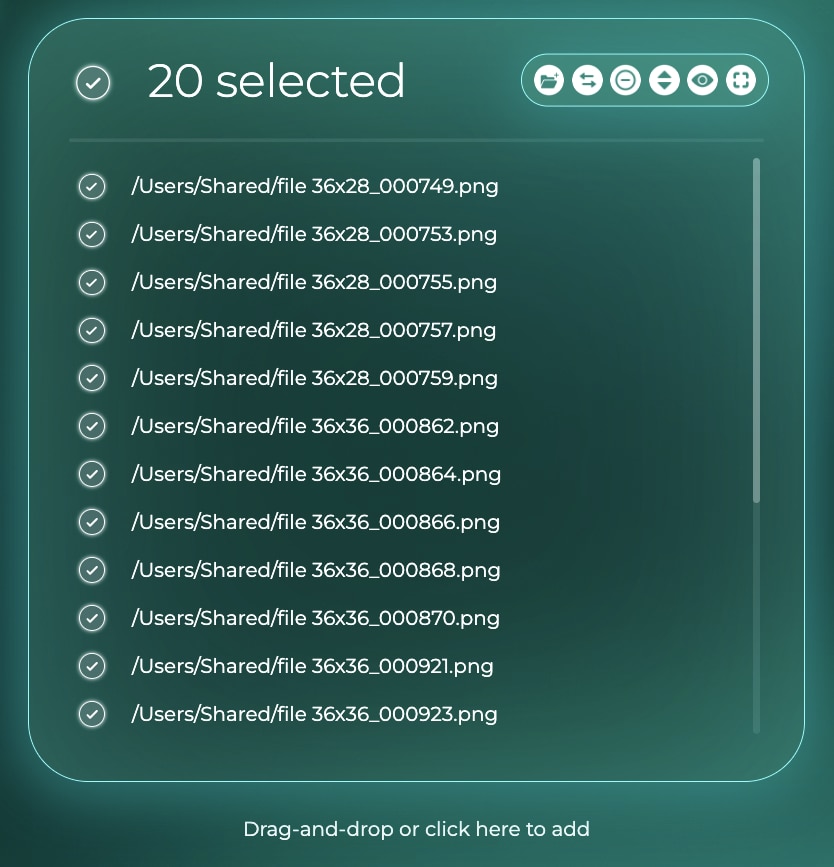
This block shows the list of files or folders you have selected for shredding. Once you start the shredding, all of the folders and files in this list will be erased.
You can use the checkboxes to adjust the list of items for shredding. Simply click on a checkbox to toggle its selection. You can also use hotkeys for quicker adjustments:
- Shift-click to select multiple items
- Cmd+A to select all
- Cmd+Shift+A to deselect all
- Cmd+I to invert the selection
- Delete or Backspace to remove items from the list
Keep in mind, the checkboxes are only for modifying the list of files/folders to be shredded—unchecking an item won’t stop it from being erased. Ultimately, everything in the list on the left will be shredded.

At the top, you'll find six buttons that allow you to modify or configure the list of items selected for shredding: "Add folder," "Invert selection," "Remove selected from the list," "Sort," "Cycle through view modes," and "Toggle fullscreen mode."
You can hover over each button to see a brief label describing its function, and click to activate the corresponding action.
Another method to modify the list of items selected for shredding is by using the buttons at the top of the list. There are 6 buttons at the top that let you change or configure the list of items you have selected for shredding.
1. Add folder: Click to open the "Finder" dialog and add more folders for shredding.
2. Invert selection: Press this button to invert your current selection of checkboxes.
3. Remove selected from the list: Click this button to remove all currently selected items from the shredding list.
4. Sort: Press this button to sort the items from A to Z or from Z to A.
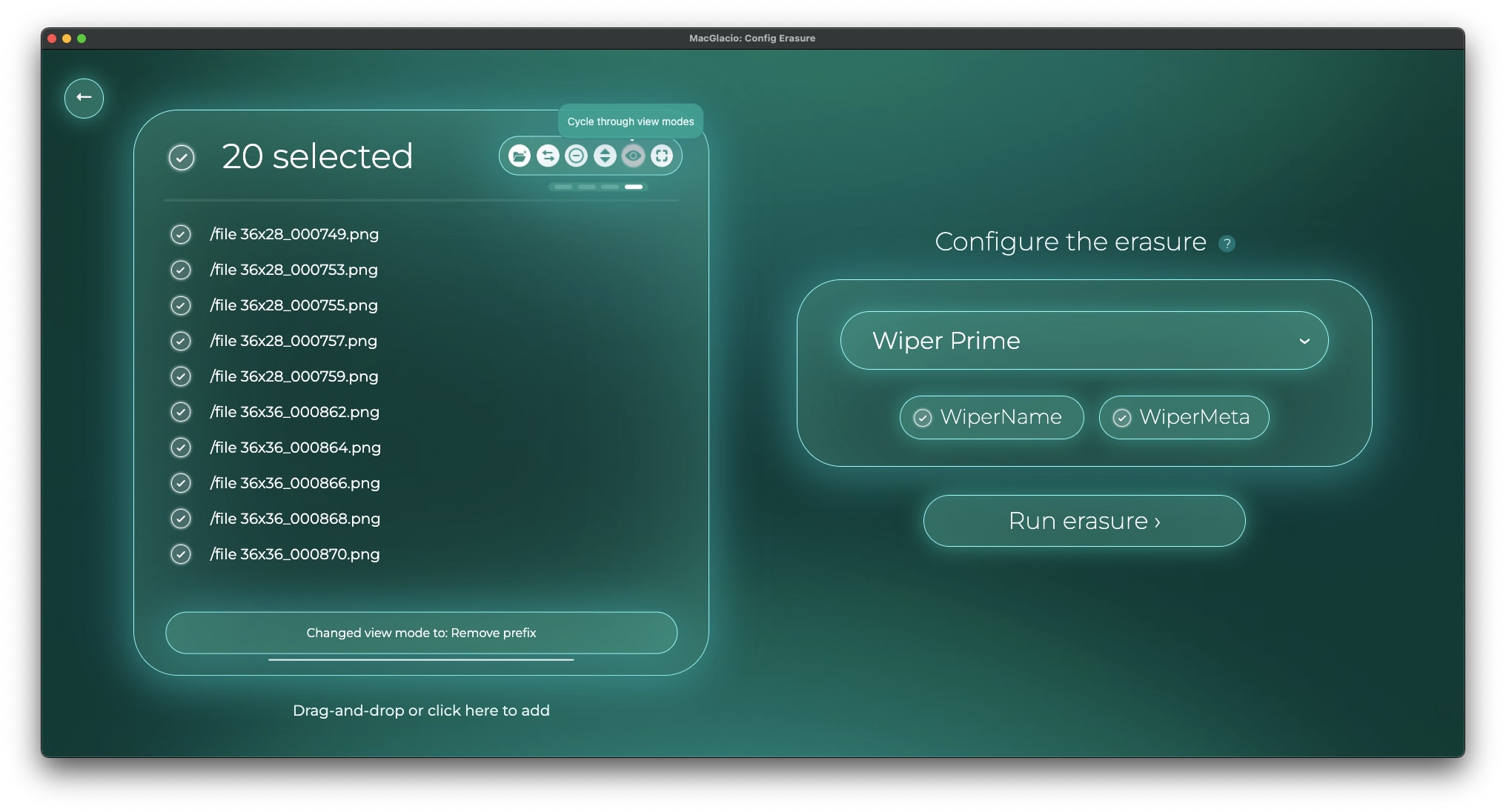
Clicking the "Cycle through view modes" button allows you to toggle between different display options for the Shredding items list. In this screenshot, the view mode is set to "remove prefix," which results in only the file names being shown, as the common parts of the paths are omitted.
5. Cycle through view modes: Click this button to toggle between four different view modes for the list:
- Default Mode: Displays the full file path of the items selected for shredding.
- File Name Mode: Shows only the file names.
- Directory + File Name Mode: Displays the last directory and the file name.
- Unique Path Tails Mode: Removes all common prefixes, showing only the unique "path tails" of the items.
You can switch between these modes by clicking the button repeatedly.
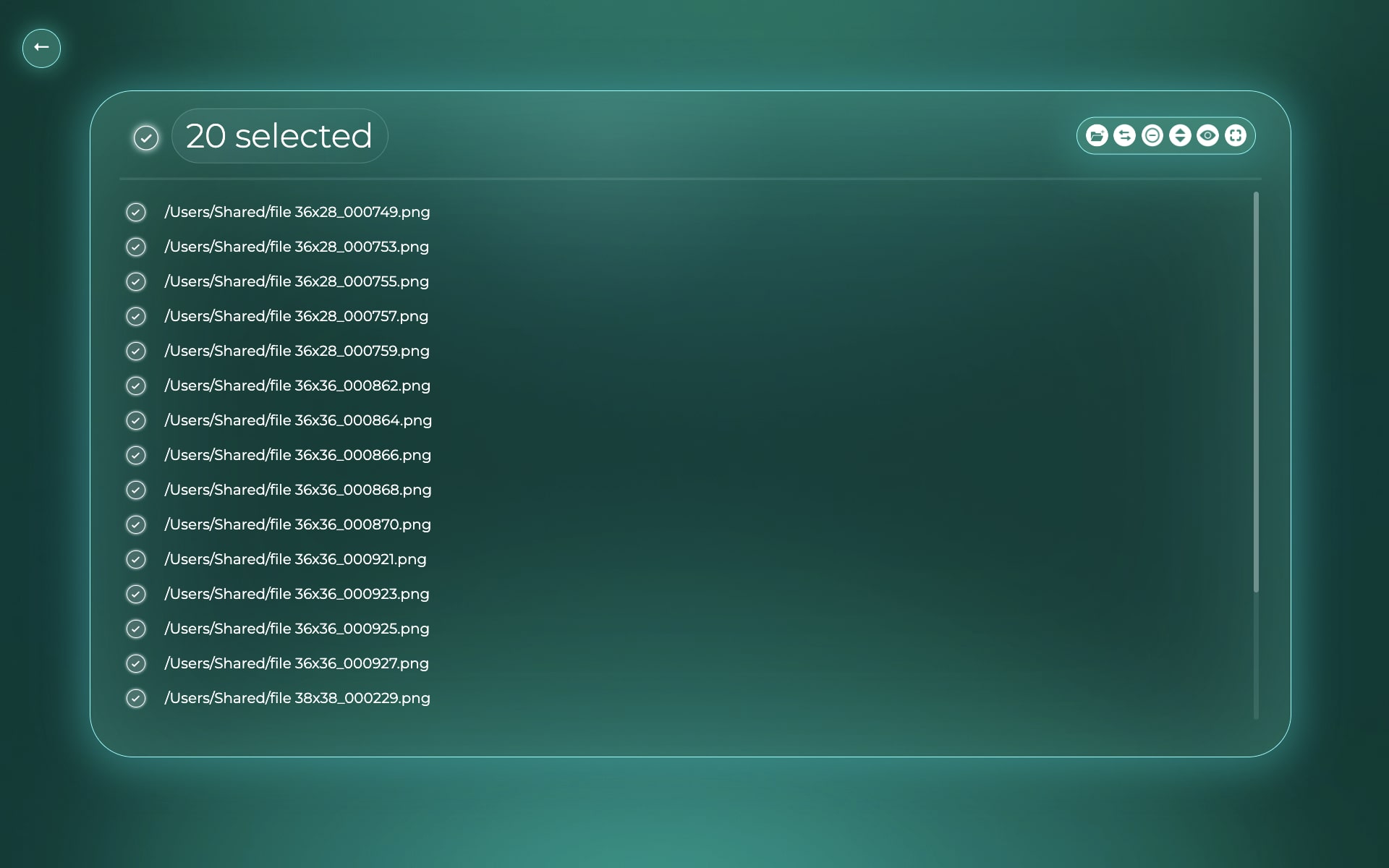
By clicking on the "Toggle fullscreen mode" button, you can toggle between the normal and fullscreen view of the shredding items list. This can be useful if you need to work with a larger number of items.
6. Toggle fullscreen mode: By clicking on this button, you can toggle between the normal and fullscreen view mode of the shredding list. This can be useful if you need to modify a large list of items for shredding.
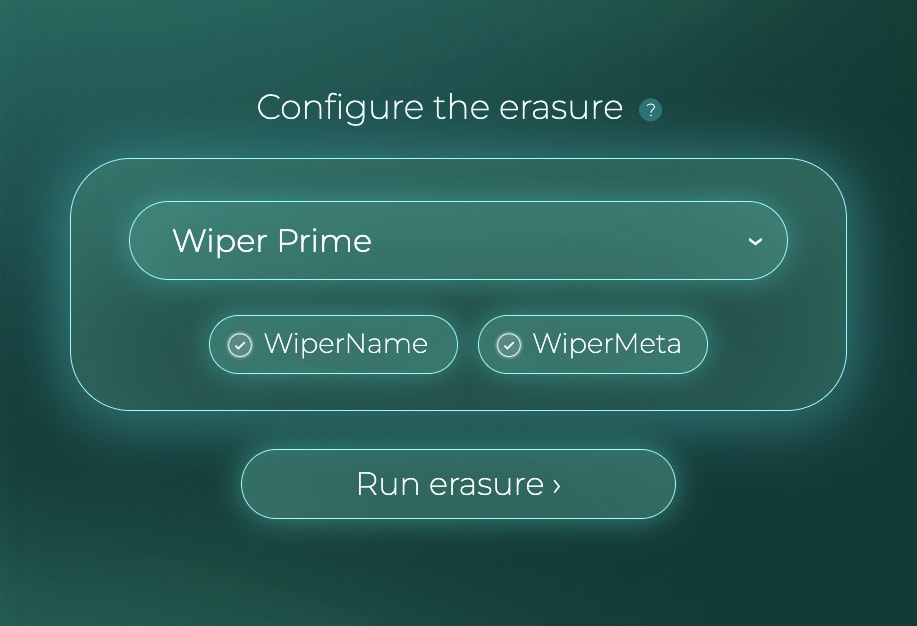
On the right side, you can change the erasure algorithm and enable or disable the WiperName and WiperMeta technologies.
Now, let's focus on the right side of the Shredding Configuration window. Here, you can adjust the erasure algorithm and enable or disable the WiperName and WiperMeta technologies. By default, the shredding algorithm is set to Wiper Prime, MacGlacio’s proprietary algorithm, which is recommended for securely erasing any files.
Additionally, the WiperName and WiperMeta options are enabled by default. WiperName is a unique feature of MacGlacio—when activated, it shreds not only the file itself but also its name and the path where it was located, enhancing privacy. WiperMeta goes a step further by erasing timestamps, modification times, creation dates, and other time-related attributes of the files and folders.
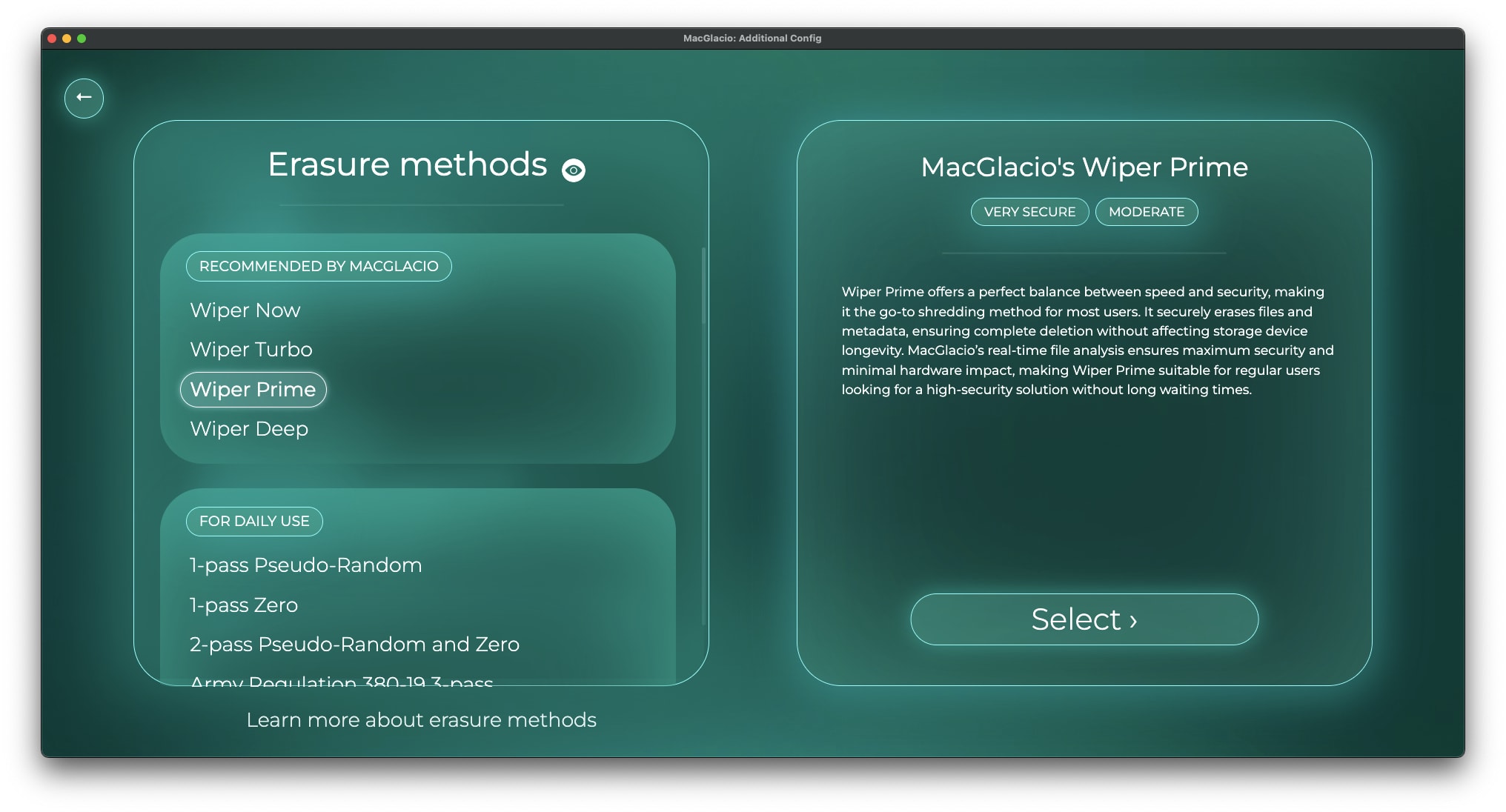
Click on the "WiperPrime" label to access MacGlacio's full list of supported erasure algorithms. You can click on any algorithm to view detailed information about it, and click "Select" to choose that algorithm for use.
To explore the wide range of erasure algorithms supported by MacGlacio, simply click on Wiper Prime and choose another algorithm. This will open a new window where you can browse all available erasure algorithms. Clicking on any algorithm will display detailed information, including its attributes and tags. You can also click the eye icon at the top to adjust how the algorithms are grouped—by factors such as country of origin, security level, hardware care level, etc.
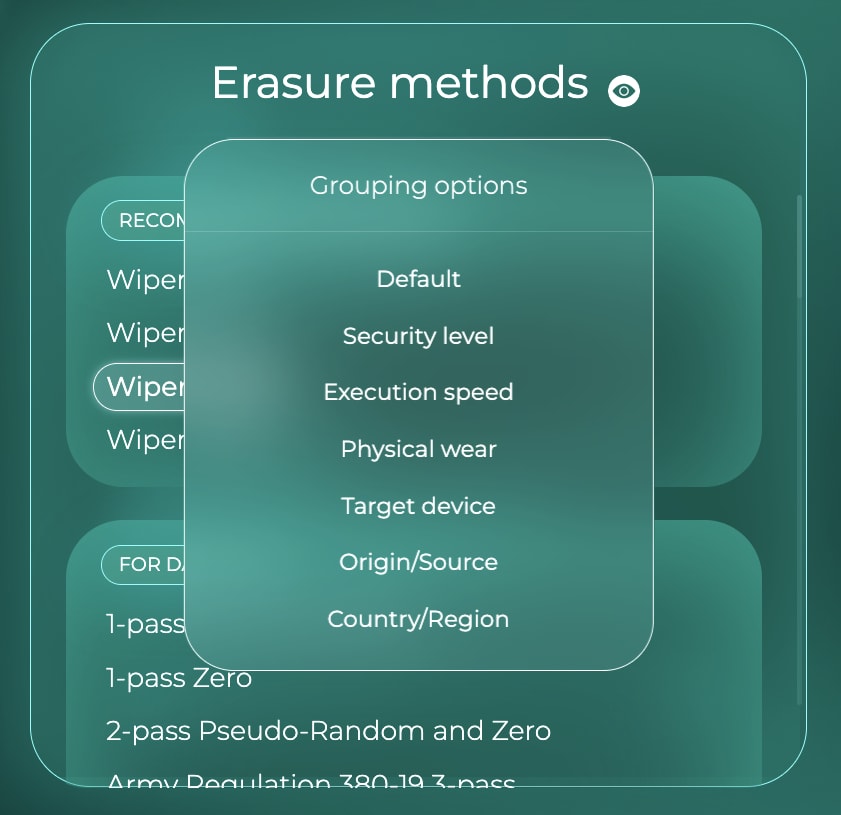
Click the eye icon at the top to switch the algorithm grouping mode for easier navigation.
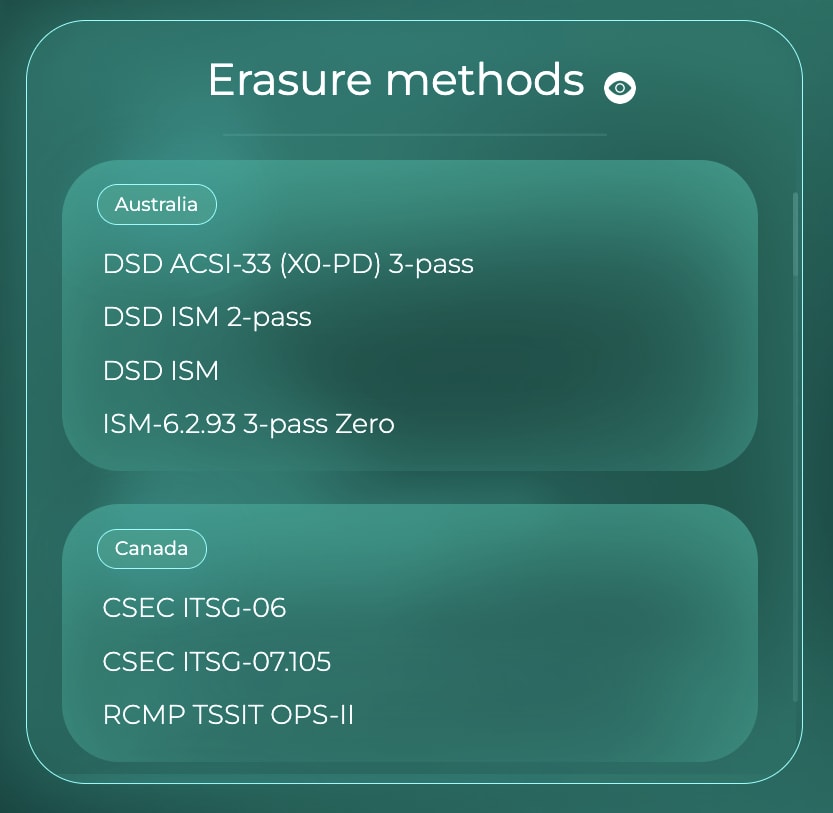
In this example, we've selected the "Country/Region" grouping method, and the algorithm list view has been updated accordingly.
Finally, once you have configured your shredding, press the "Run erasure" button to start the shredding process. All of the files and folders currently in the shredding list will be erased.

Click on the "Run Erasure" button to begin the shredding process.
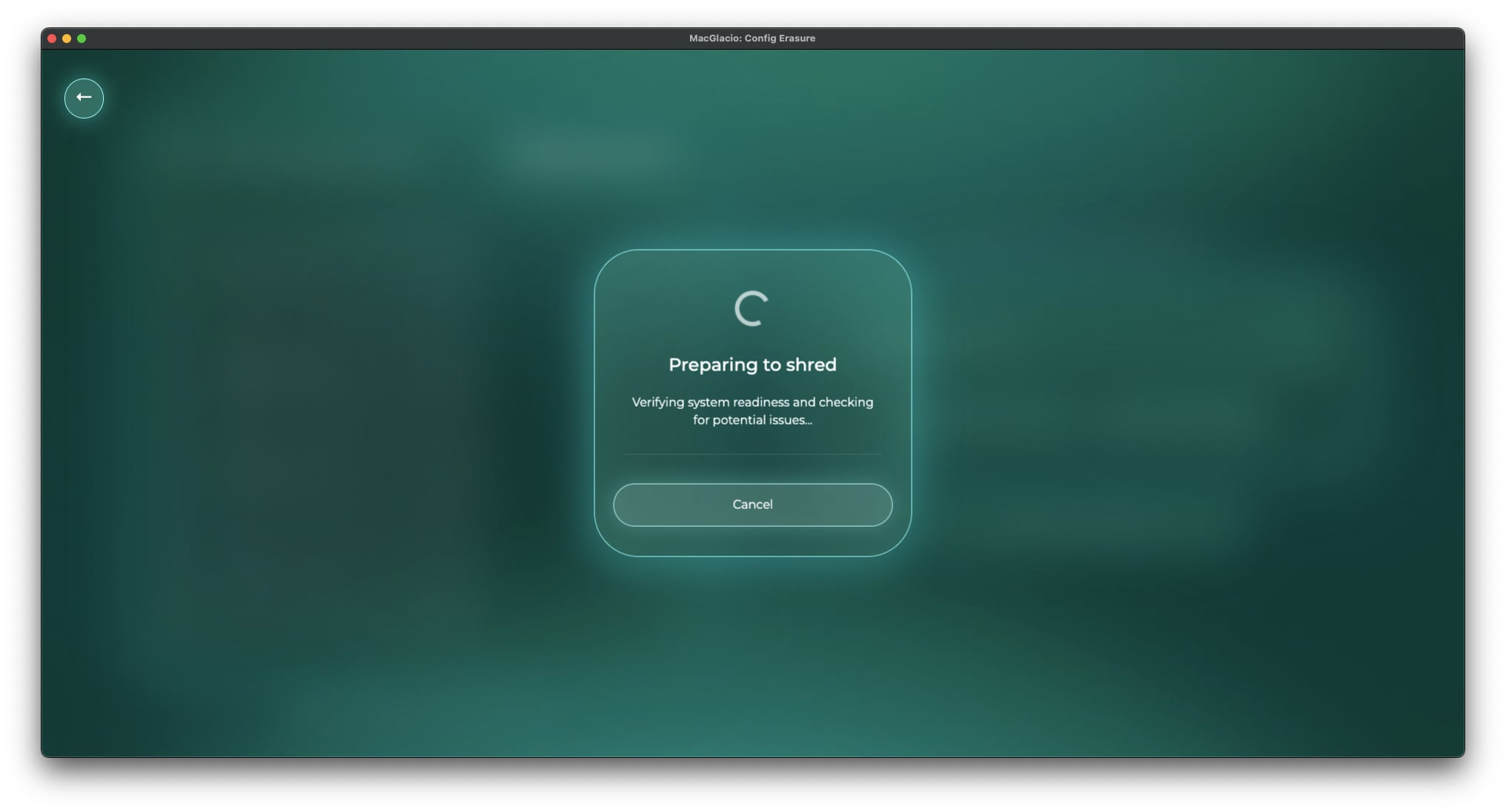
MacGlacio will perform file system checks to ensure the shredding functions properly.
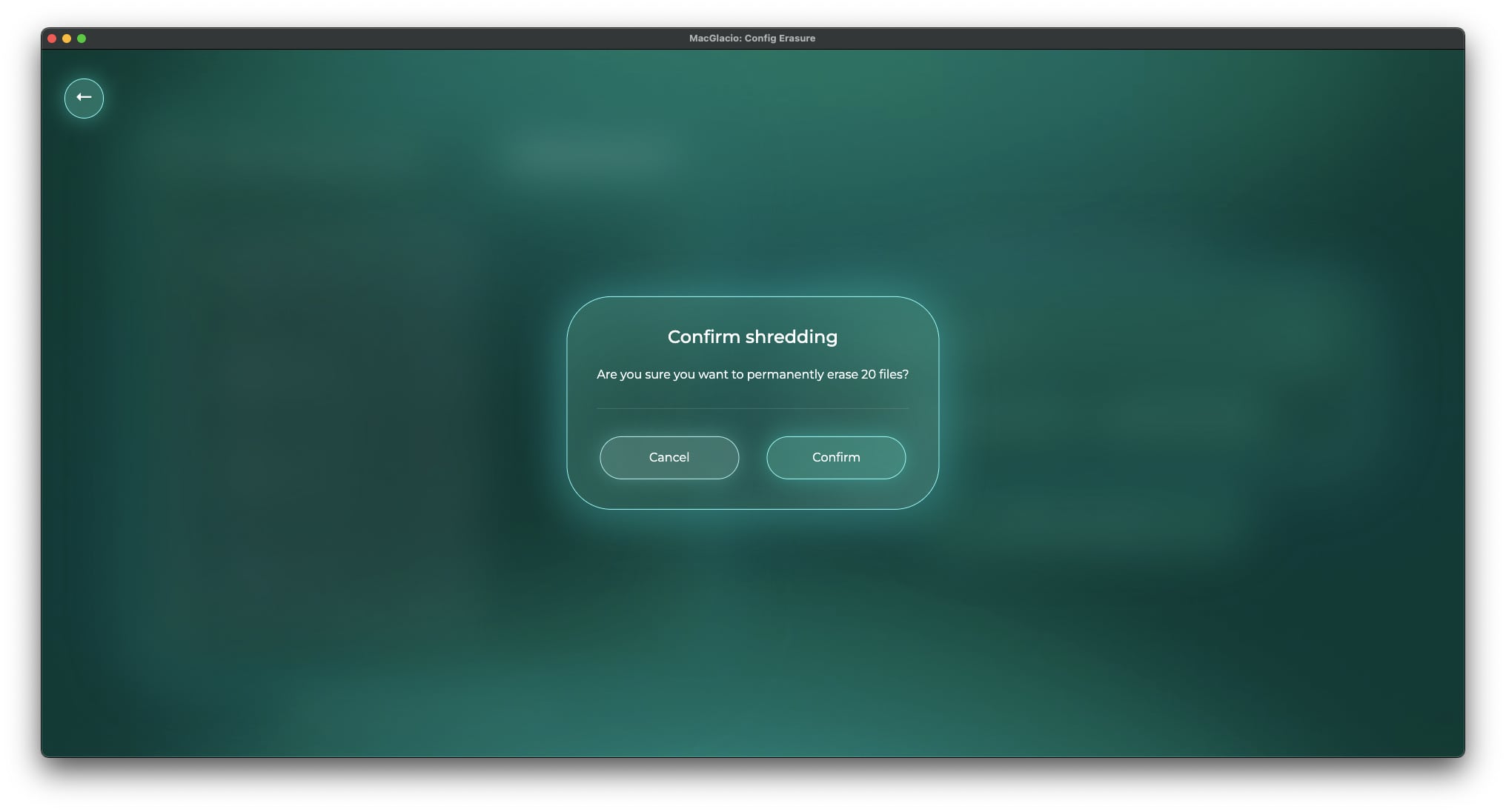
Finally, confirm the shredding to proceed. All data will be permanently erased.
Once the erasure is confirmed, MacGlacio will begin shredding your files.
› During the Shredding
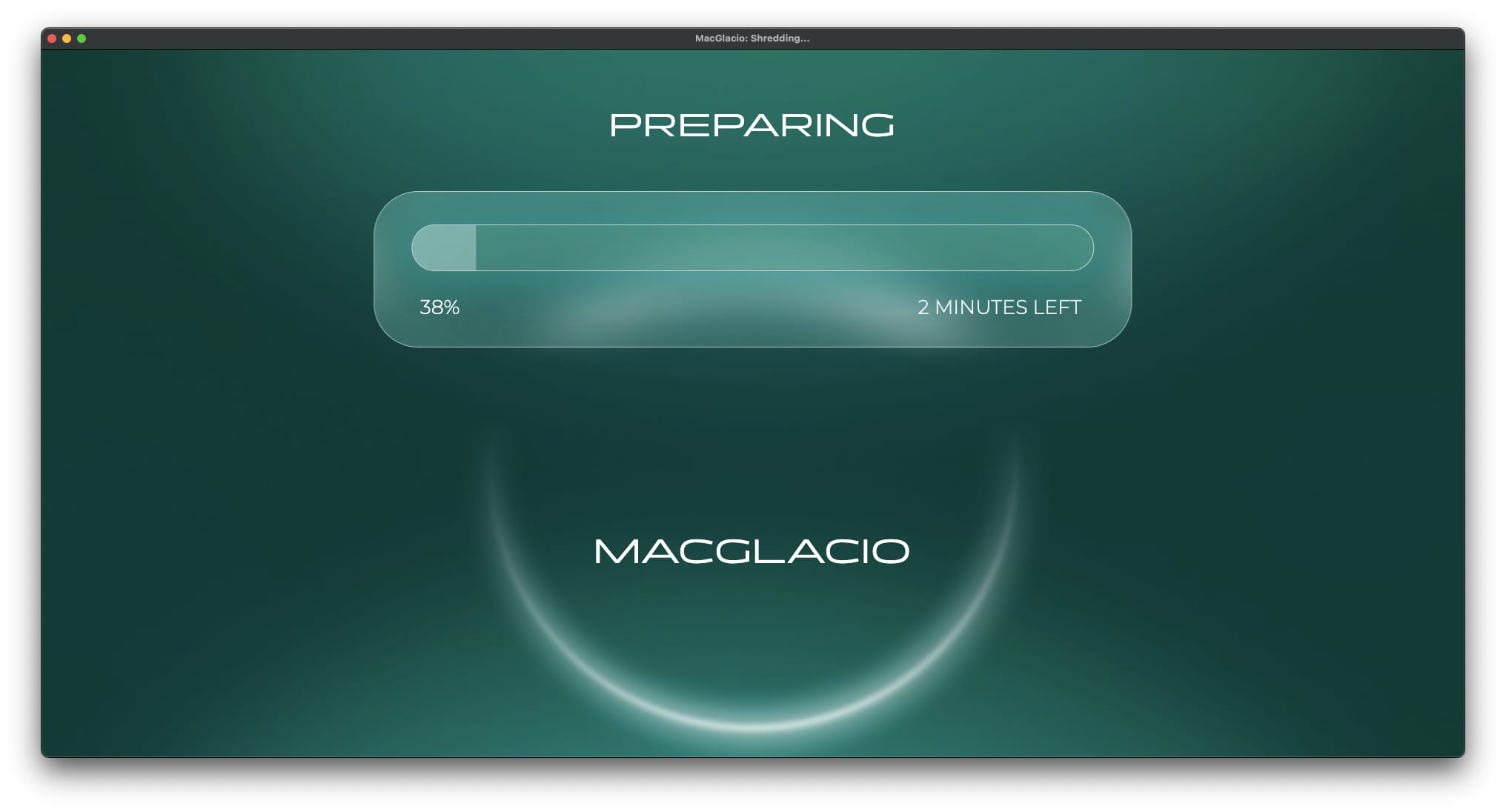
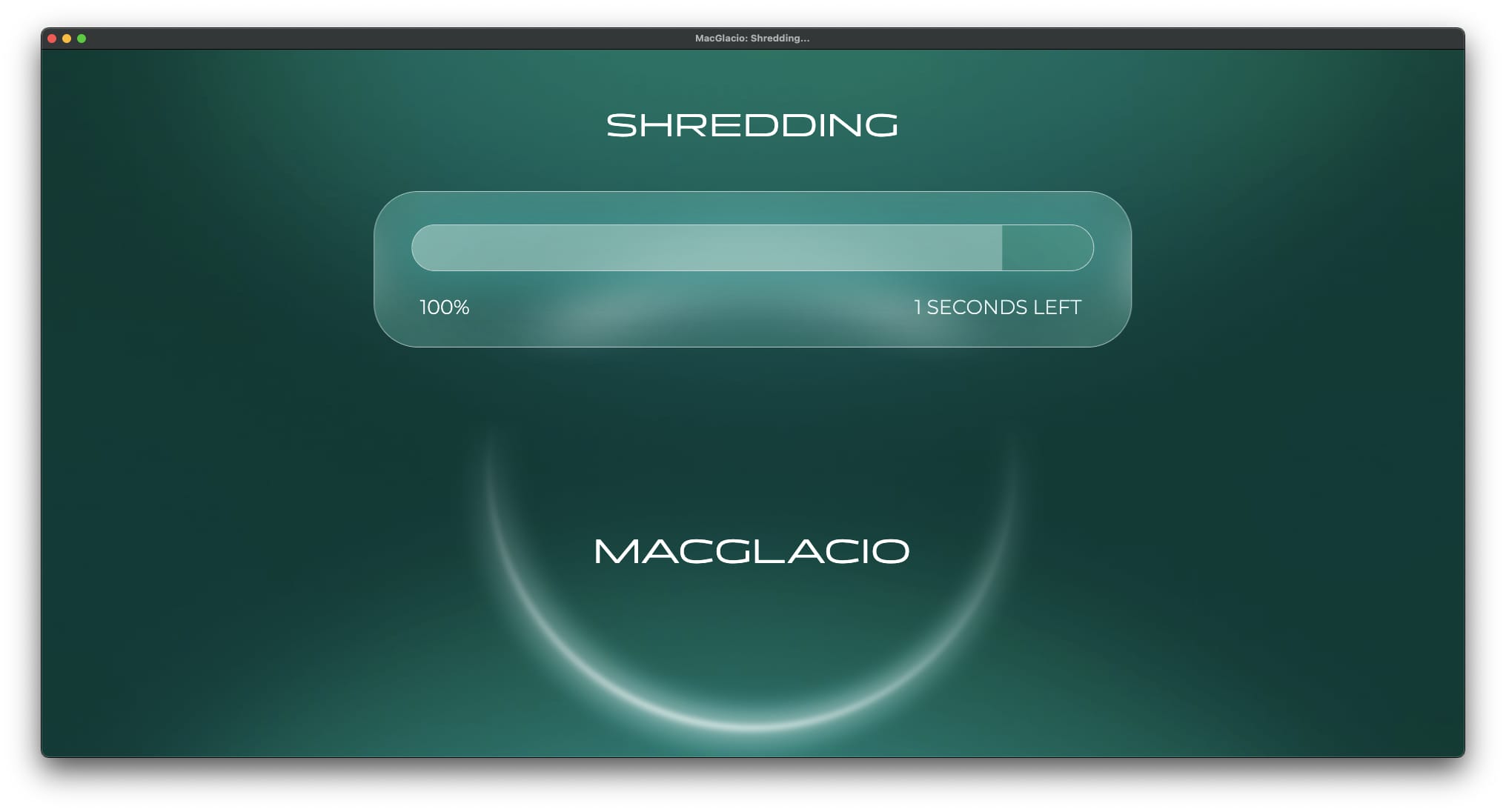
Once shredding begins, you can monitor its status, progress, and estimated completion time in real time. Please be patient as MacGlacio securely erases the files. The process may take some time, depending on the speed of your storage devices, the size of the files being shredded, and the number of individual files and folders.
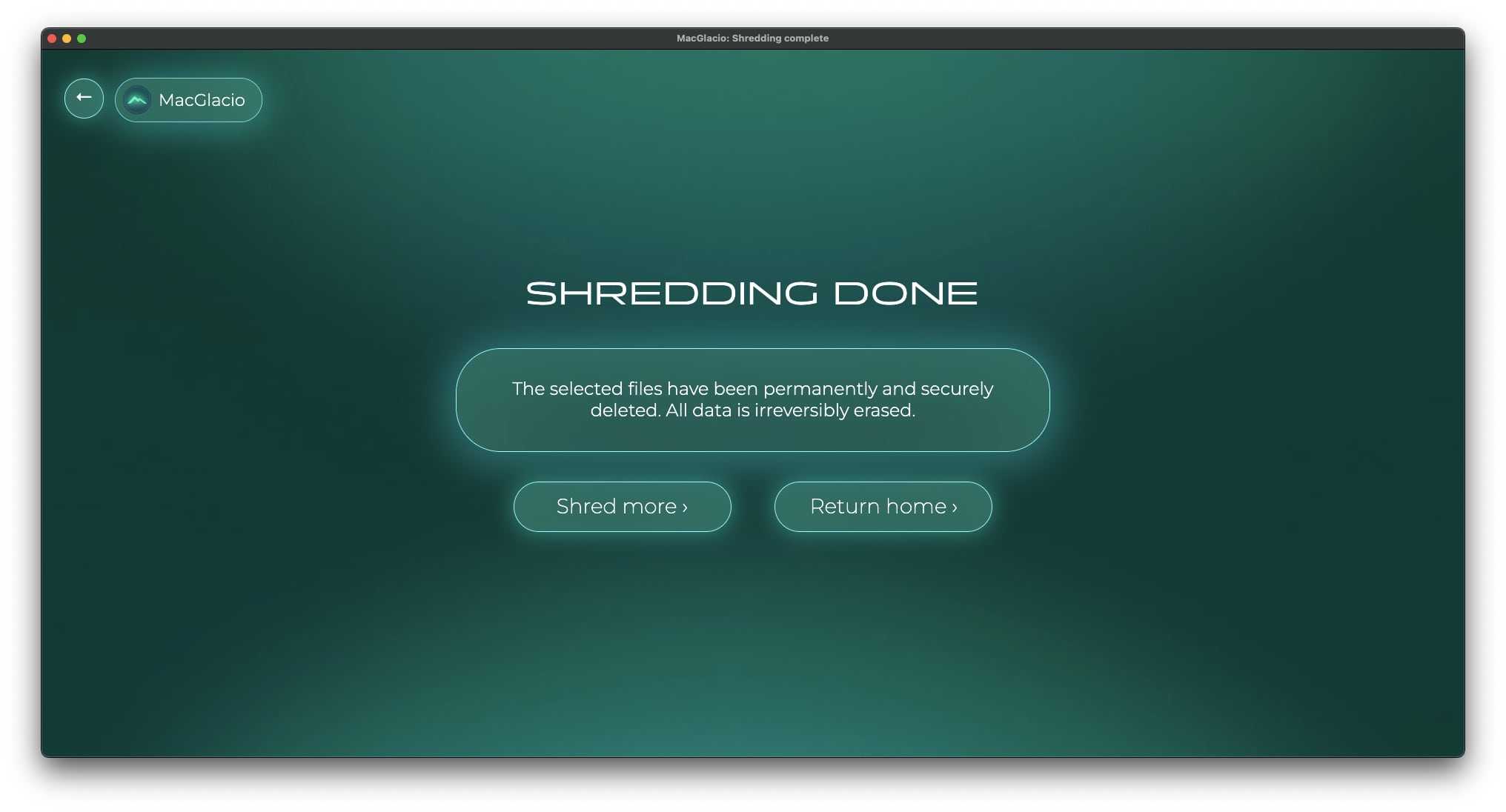
Once the shredding is complete, MacGlacio will display a "Shredding Done" page, confirming that the files and folders have been securely erased.
If, for any reason, the shredding was unsuccessful, MacGlacio will provide details about the files or folders it couldn’t erase. This typically occurs if the files or folders had "Read-only" access, were in use by other software on your Mac, were being used by macOS itself, or if there were permission errors.
In such cases, we recommend ensuring that no other software is blocking access to the files or folders you wish to delete, that you have the necessary permissions to remove them, and that the storage device is not write-locked (as is common with many SD cards). A simple solution to ensure no other program is blocking access is to restart your computer. If the issue persists and you're unable to shred files, you may want to check the currently running programs through the "Activity Monitor."
Additionally, please note that if the shredding did not complete successfully, some files or folders may appear under different names—this is normal. If an external factor interrupted the process, MacGlacio may have been able to rename or partially erase the file, but not delete it entirely. As a result, you might come across unexpected file or folder names, such as "AAAAAAAAAAAAAAAAAA," "BBBBBBBBBBBBBBBB," or other unfamiliar labels.
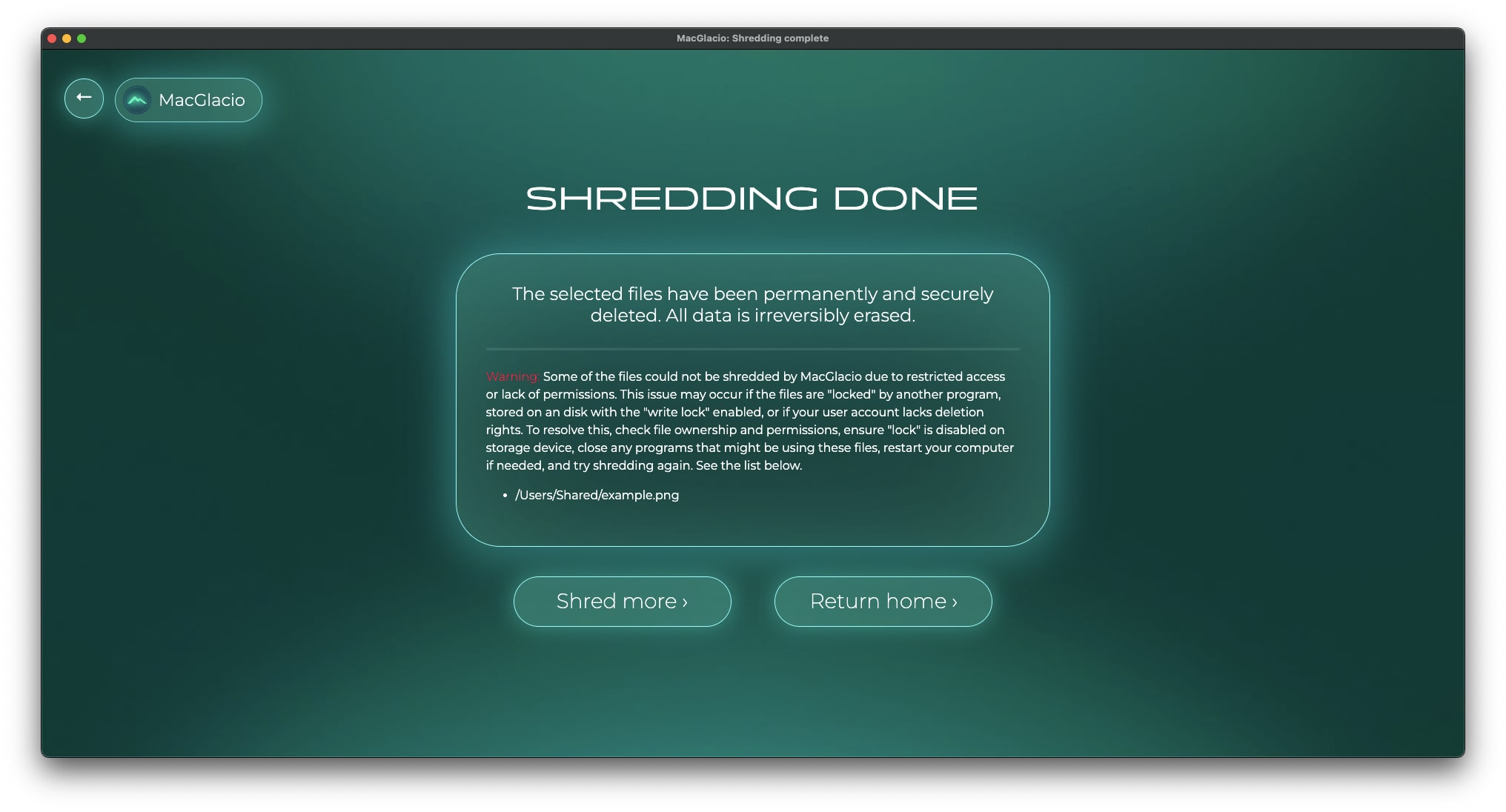
If some files or folders have not been shredded by MacGlacio, you’ll see similar error information. For your convenience, you can use your mouse or hotkeys (like Cmd+A) to copy the complete list of paths that weren’t deleted.
› Shredding the Trash

From the Main window menu, click on the "Trash" option.
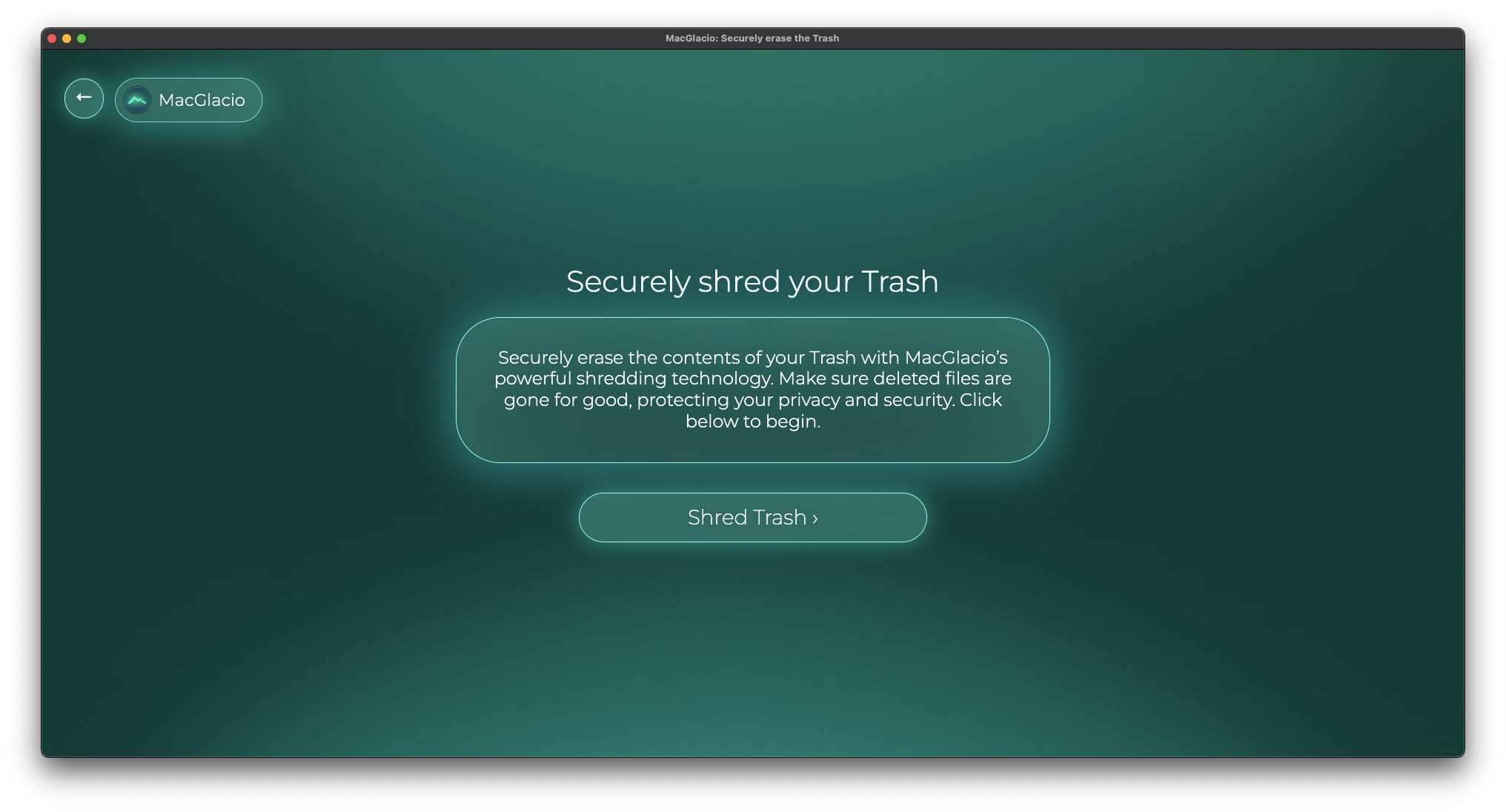
Use this window to securely shred the contents of your Trash.
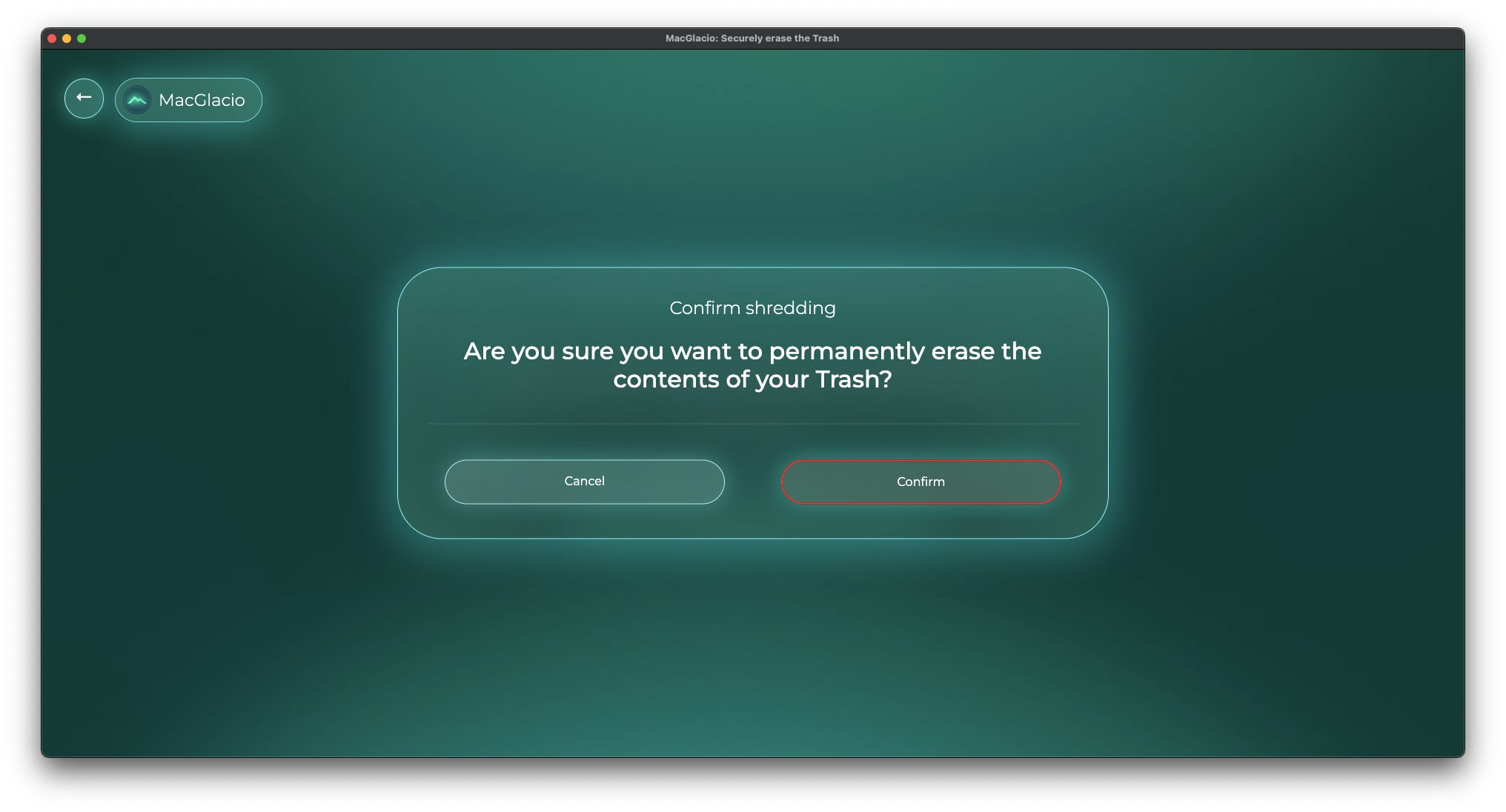
Confirm the shredding to proceed. All data will be permanently erased.
MacGlacio makes it easy to securely shred the contents of your Trash. To do so, simply click the "Trash" option in the Main window menu. Then, click the "Shred Trash" button and confirm the shredding. Afterward, you'll see the standard shredding progress window.
› Settings
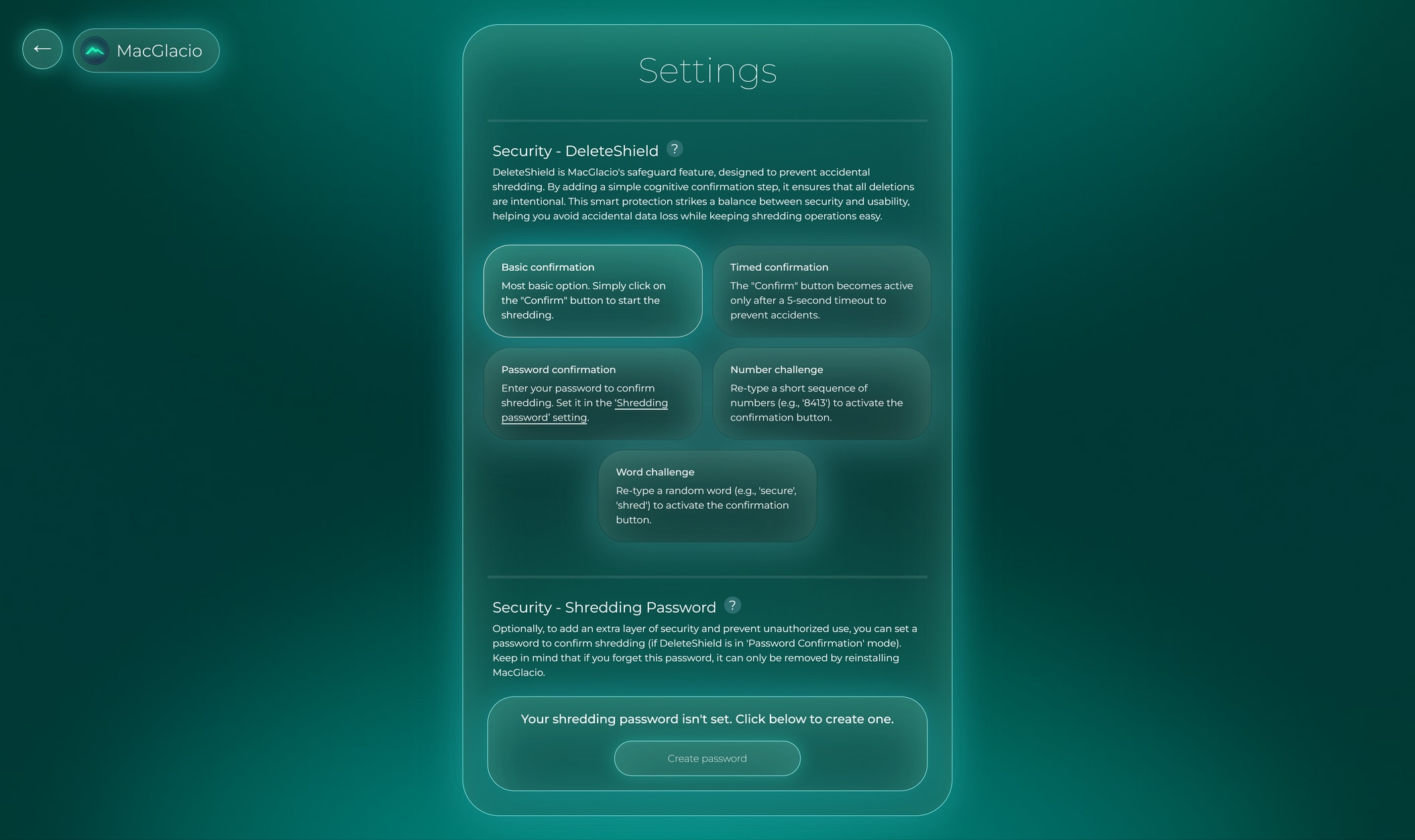
MacGlacio's Settings window.
From the Main window menu, you can access MacGlacio's settings. In the Settings window, you'll find options to configure how DeleteShield protects against accidental file deletions.
DeleteShield is a powerful feature that helps prevent unintentional deletions by requiring users to confirm their actions through customizable confirmation dialogs. These dialogs include:
- Rewriting a word
- Entering a sequence of numbers
- Authorizing shredding with a password
- Setting up a timed confirmation
In the Settings window, you can adjust the DeleteShield mode to fit your preferences. Once you're finished, simply click the "Back" button in the top-left corner. Any changes you make are saved automatically.
› Floating Menu
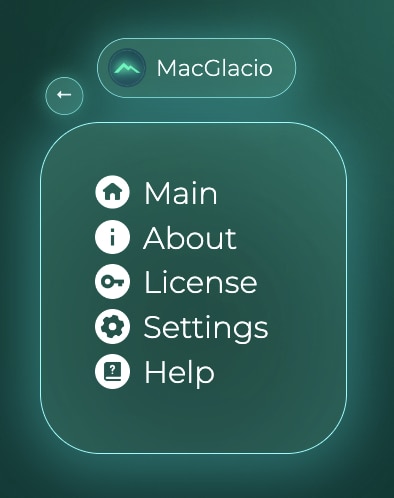
MacGlacio's floating menu in the open state. Click the "←" symbol to go back, or click the "MacGlacio" label to toggle the floating menu.
In the top-left corner of the window, next to the "Back" button ("←" symbol), you'll occasionally see MacGlacio's floating menu, which provides quick navigation options within the program.
› Themes
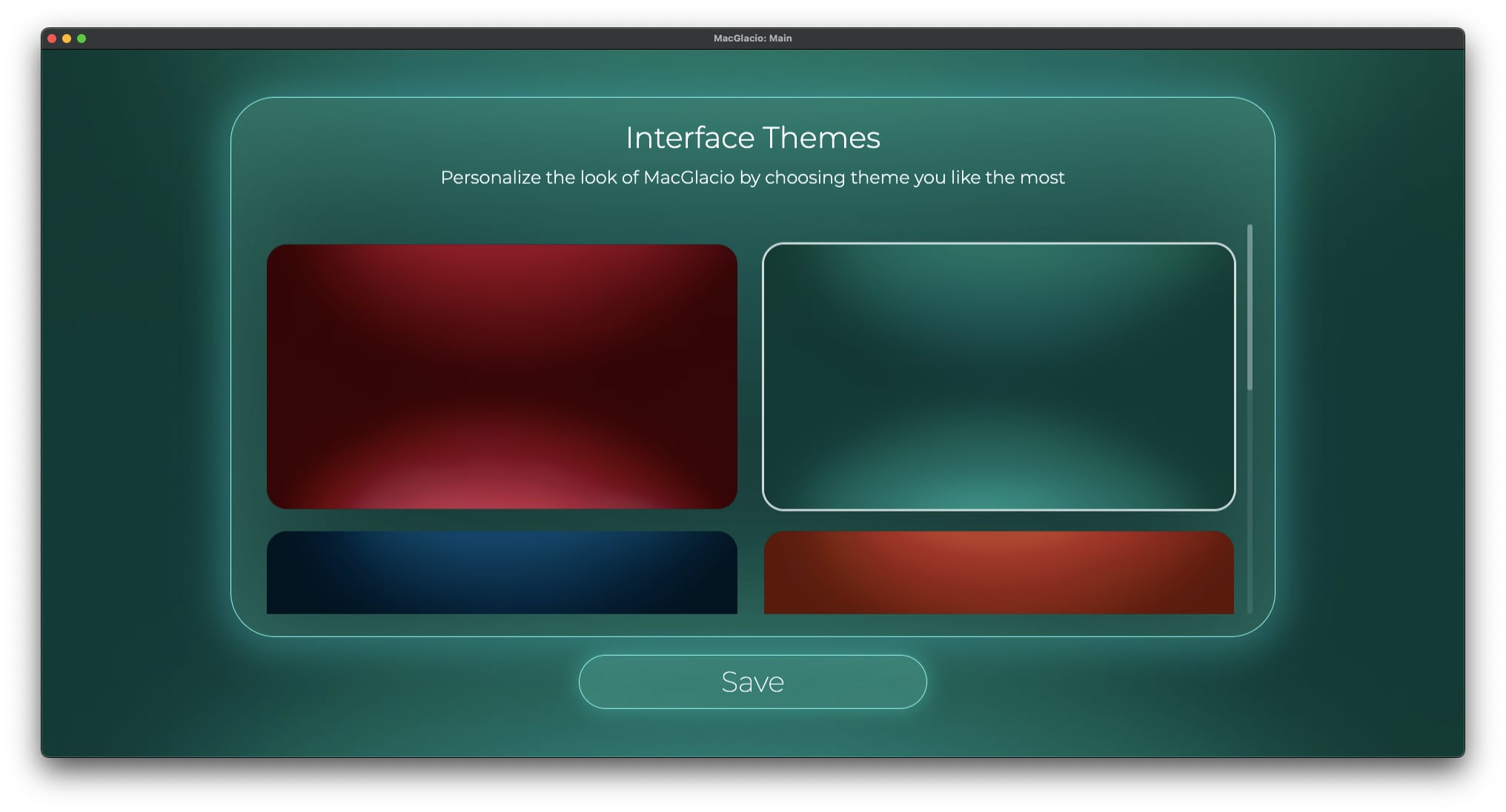
MacGlacio allows you to customize the interface with different "themes," letting you adjust the look and feel to your liking. Themes change the appearance of all windows within MacGlacio, including the splash screen that appears when the program starts. There are 6 themes available. To preview a theme, simply click on the image. To save your selection, click the "Save" button. You can access the "Themes" page through the pop-up menu on the main screen.
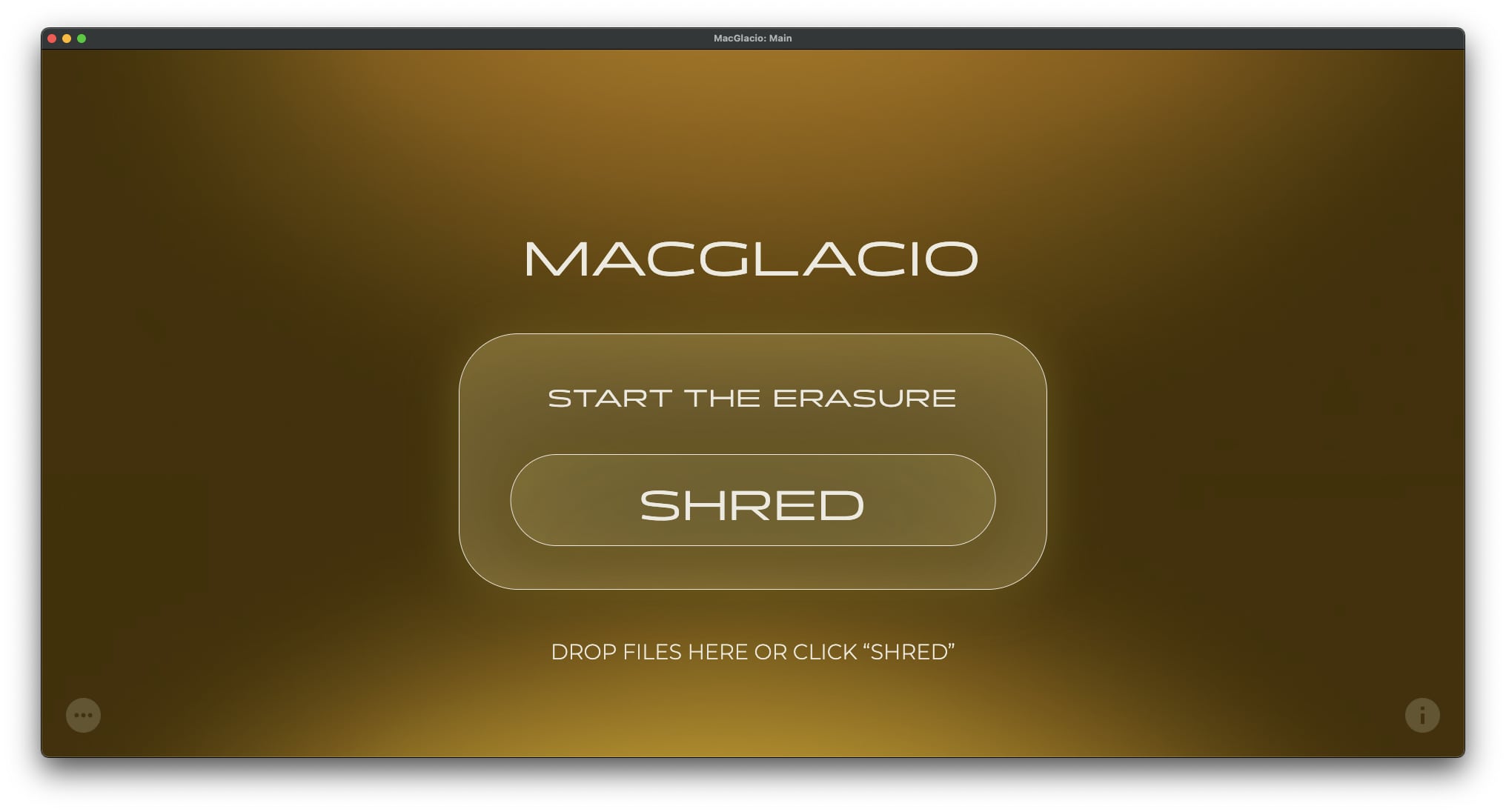
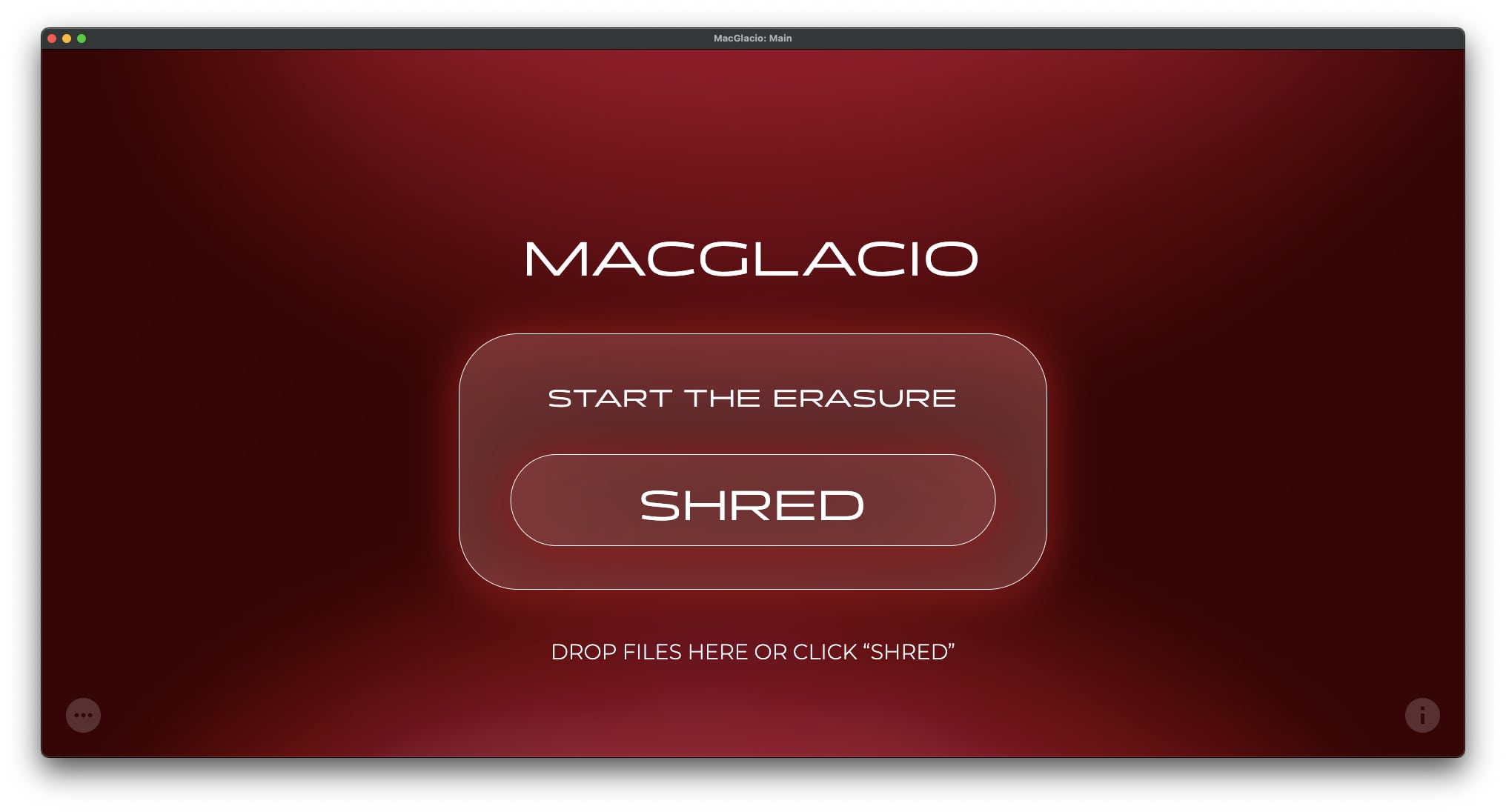
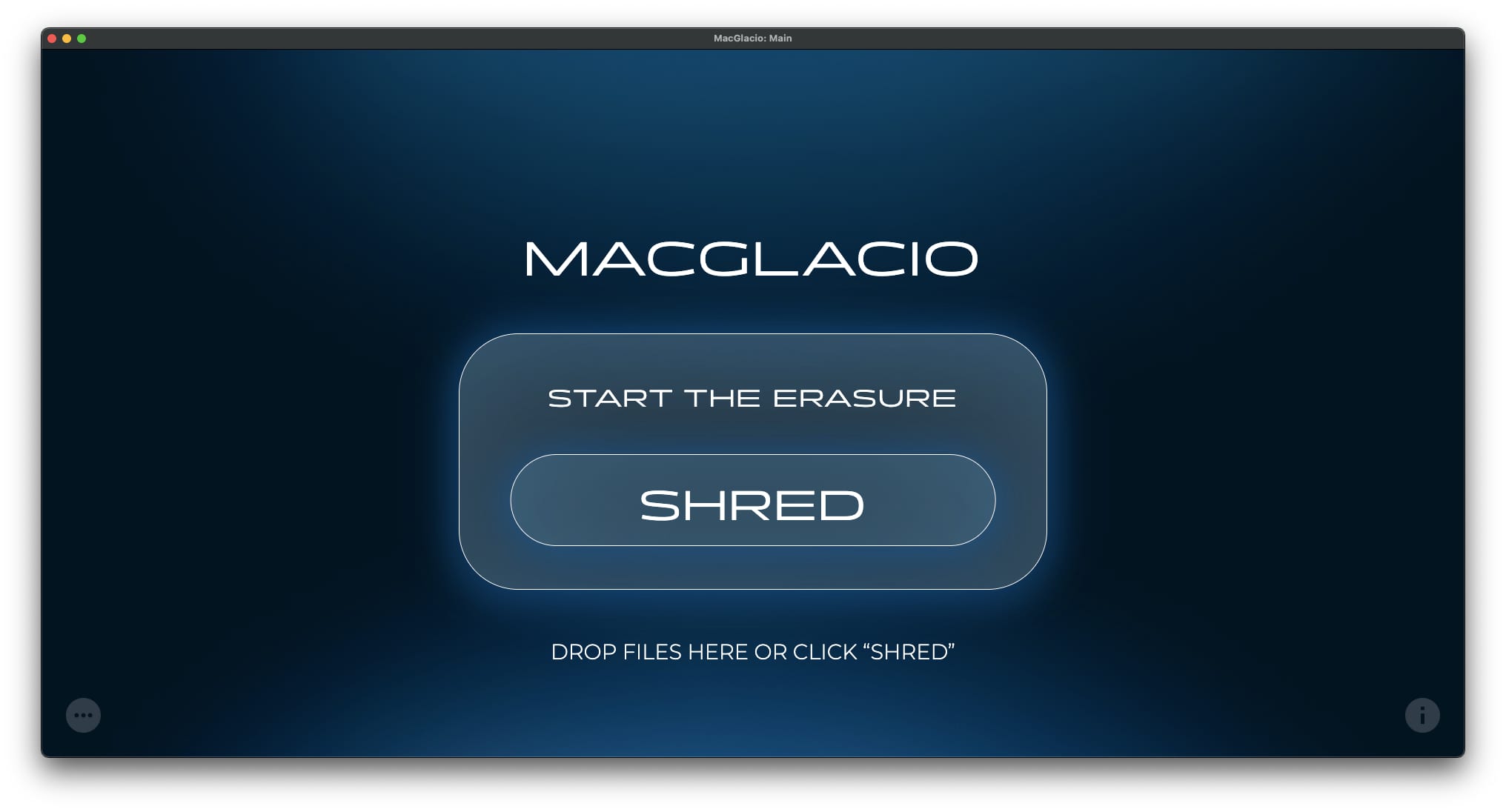
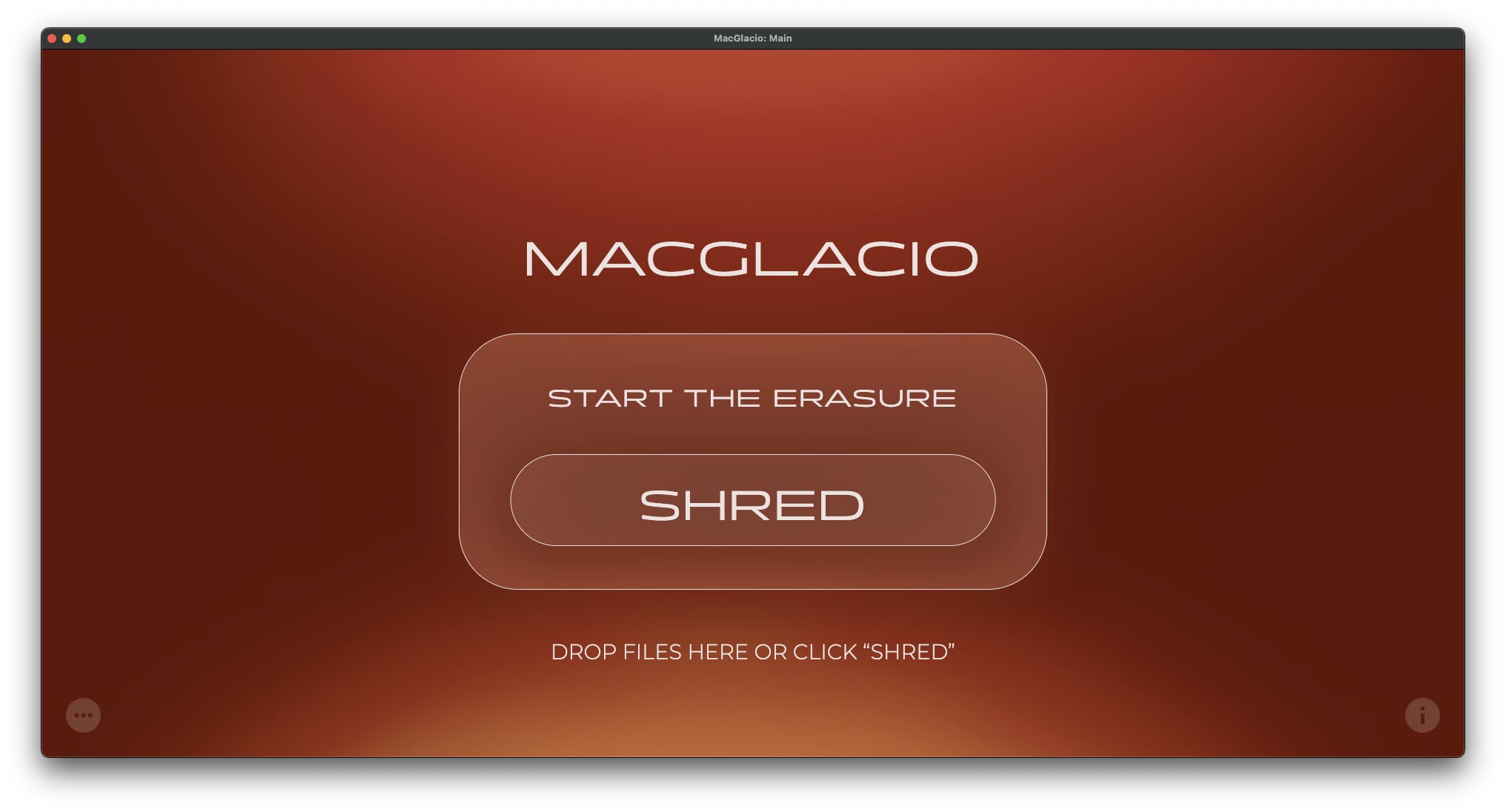
› License Information
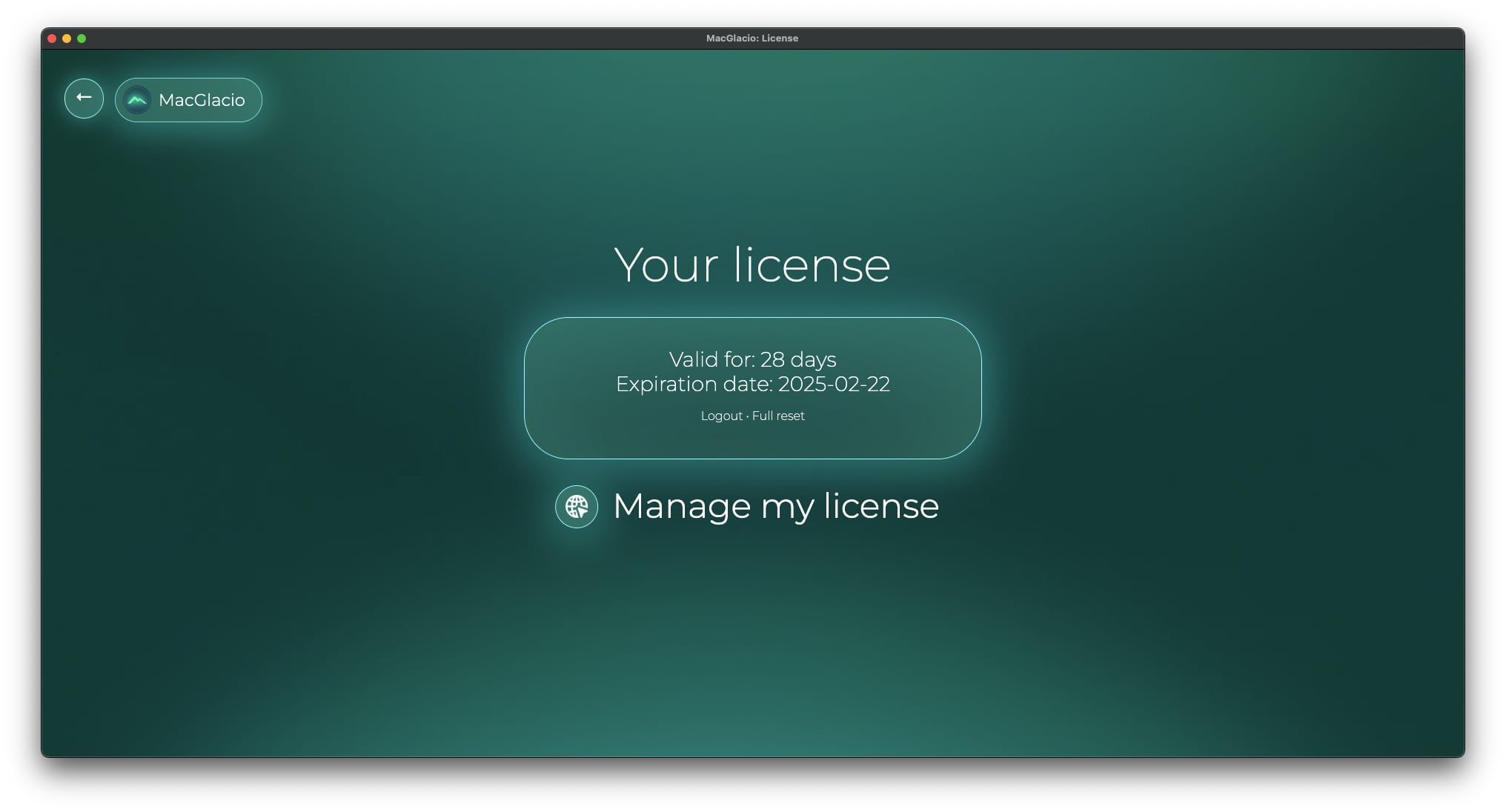
In this window, you can view your license’s expiration date and quickly access the Ambeteco Account page, where you'll also find the "Machines Manager" tool. Additionally, you can log out of your Ambeteco account or reset the program settings entirely.
› About Window

This window provides details about the current version of MacGlacio, along with links to our website and social media accounts. You’ll also find links to our other software products and additional legal information.
› Common issues
Due to the restrictive nature of macOS and the powerful capabilities of MacGlacio, some users may encounter certain issues while using the program. Please refer to the steps below for resolving these issues:
Issue 1: MacGlacio prompts for "Removable volume access."
Resolution: MacGlacio requires access to removable volumes to function correctly. If macOS prompts you to grant MacGlacio access to files on removable volumes, please click the "Allow" button in the prompt window to proceed.
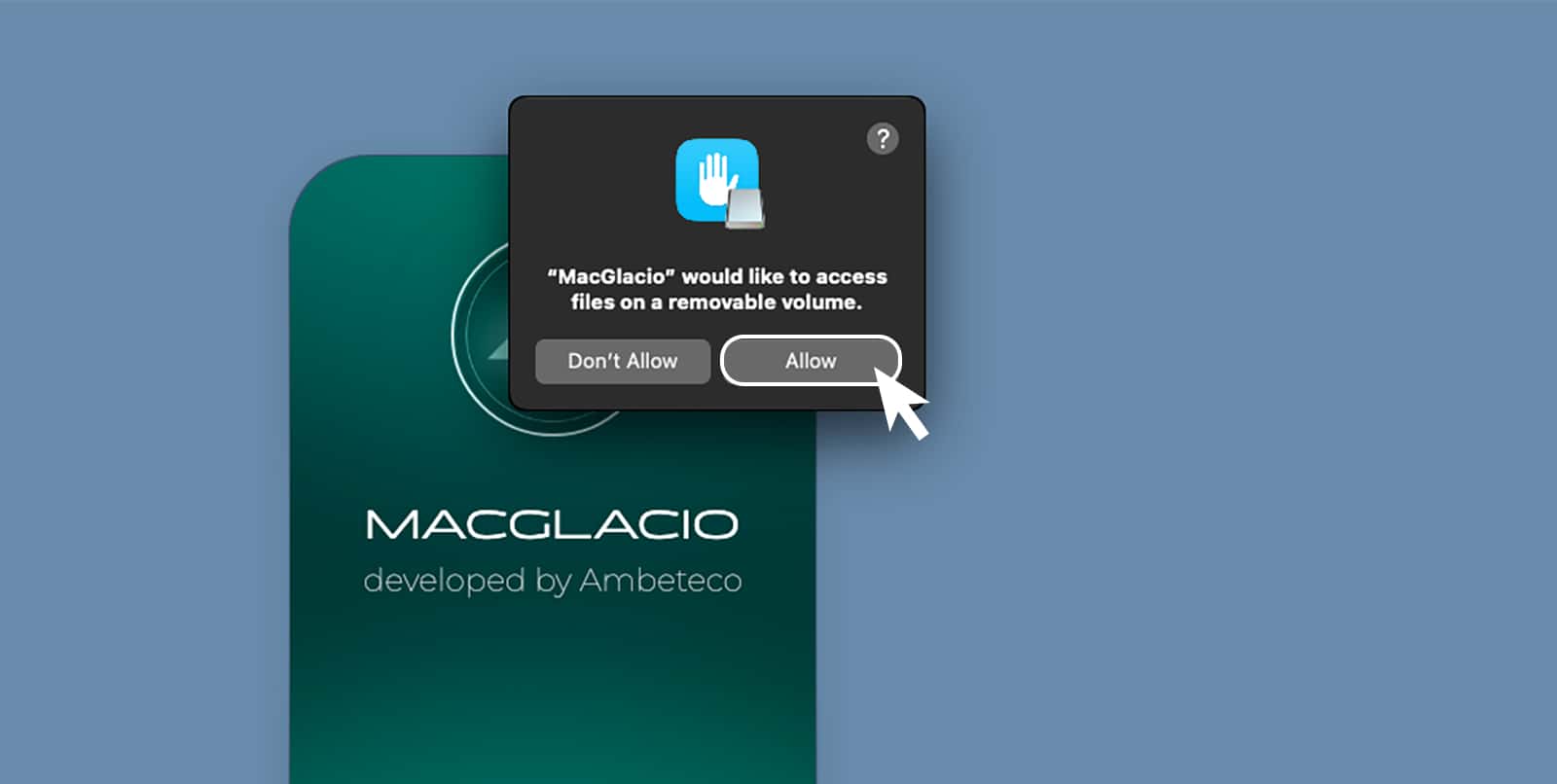
Click on the "Allow" button to proceed.
Issue 2: The "Shred with MacGlacio" option is missing from the Finder's right-click menu.
Resolution: This issue often occurs because macOS may automatically disable installed "Services," including the "Shred with MacGlacio" feature. Follow the steps below to enable it:
- Right-click on any file or folder in Finder where the "Shred with MacGlacio" option should appear.
- Select "Quick Actions" from the menu, then click "Customize..." in the sub-menu.
- System Settings will open. In the displayed list, locate the "Shred with MacGlacio" item and check its box to activate the service.
- Once activated, right-click on any file or folder in Finder, and the "Shred with MacGlacio" option should now appear in the menu.
- You might need to restart your Mac for the changes to take effect.
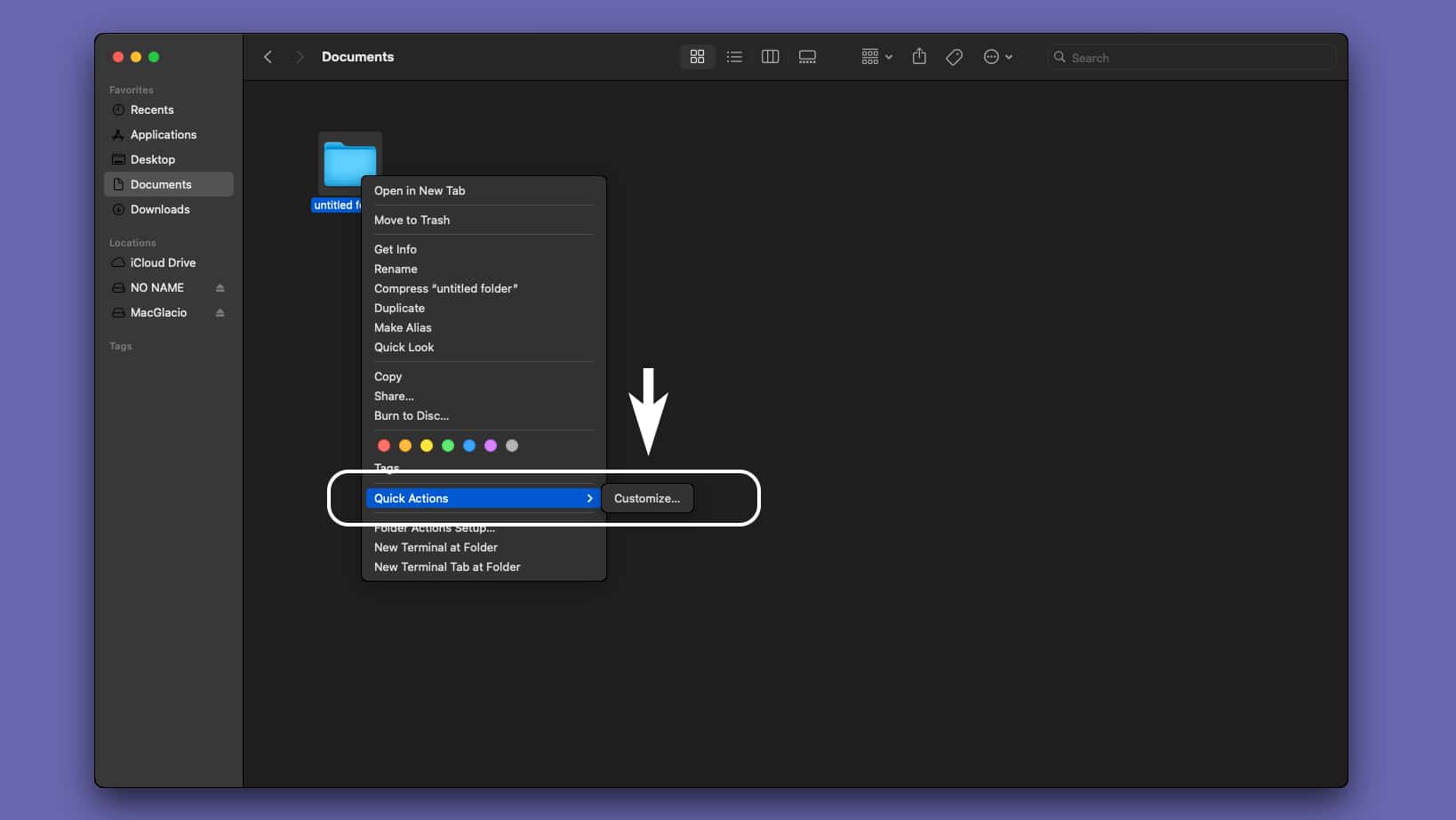
Right-click any file or folder in Finder. Then, click "Quick Actions" > "Customize...".
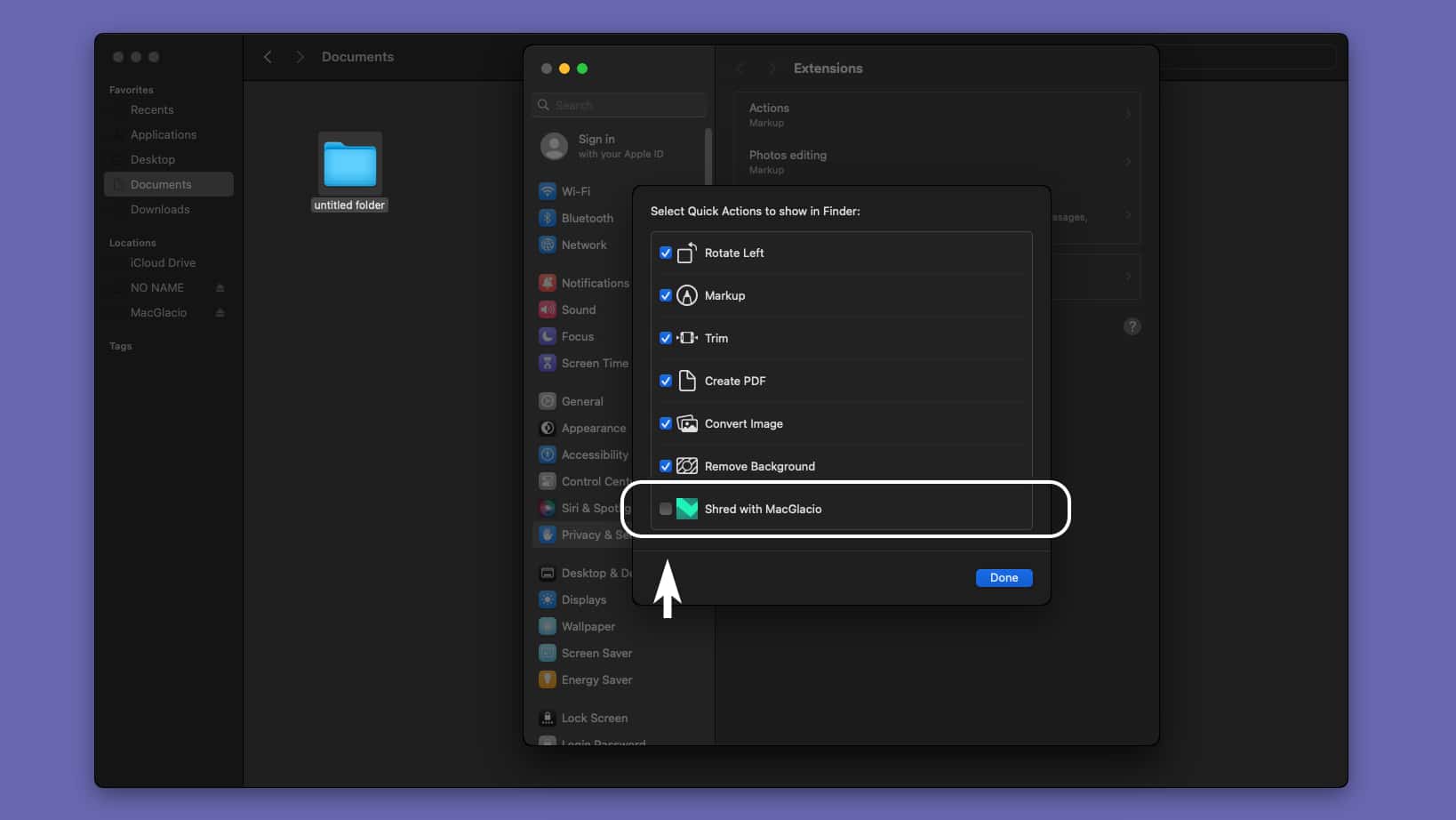
Locate MacGlacio in the list.
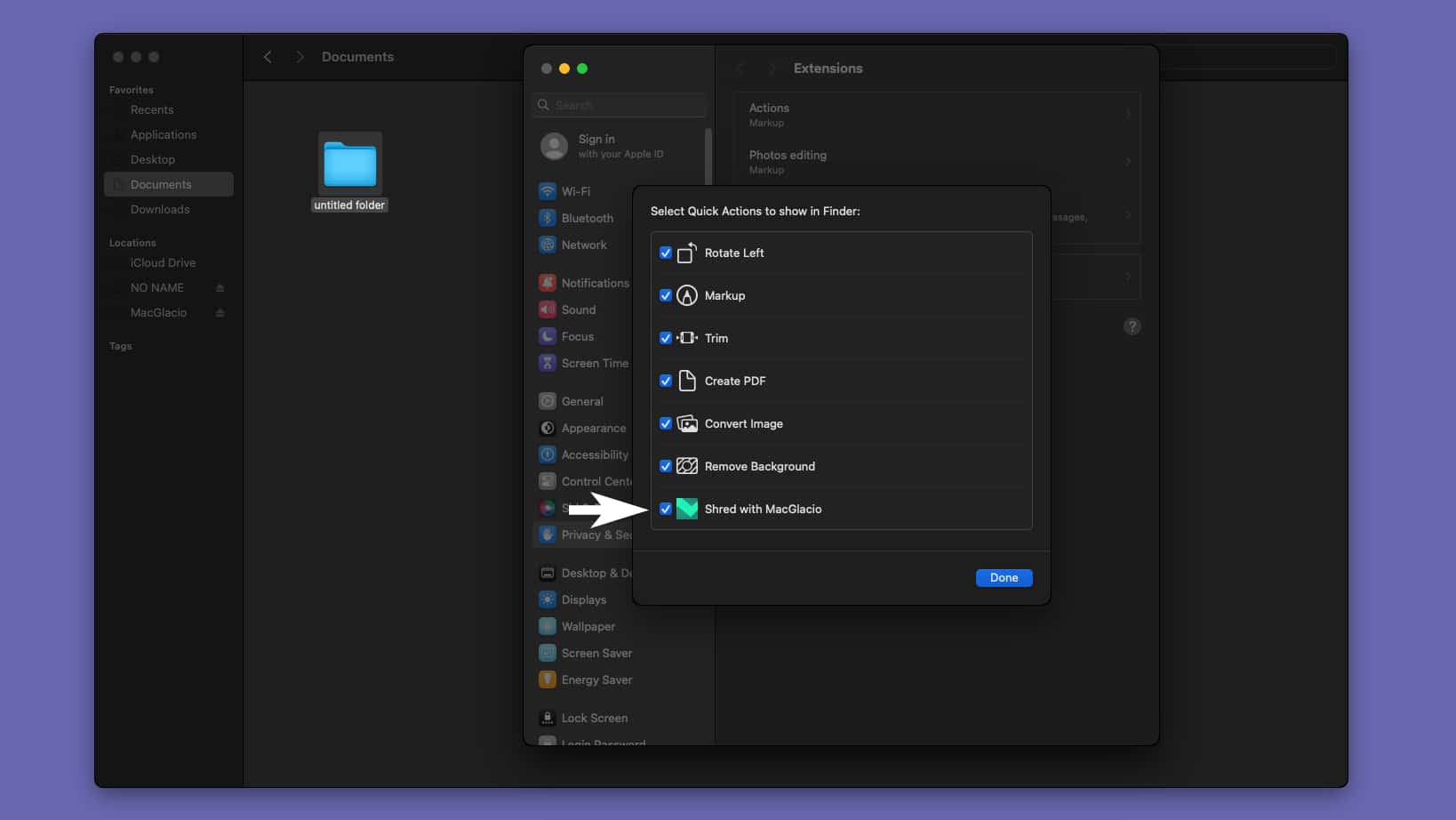
Click on the box to activate it.
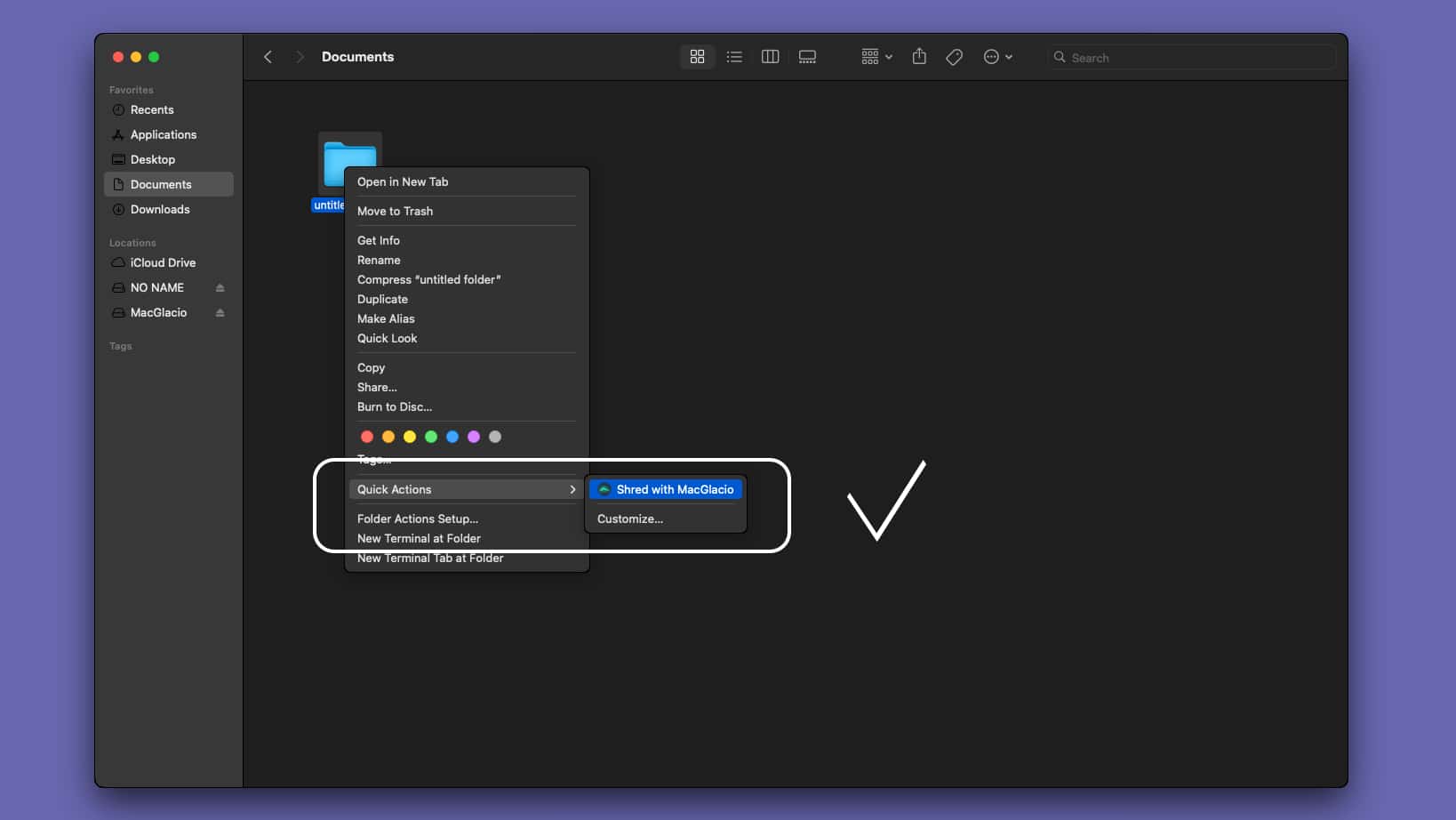
"Shred with MacGlacio" option should now appear correctly.
Issue 3: MacGlacio does not shred the contents of the Trash.
Resolution: On some Macs, particularly those running the latest versions of macOS, MacGlacio requires "Full Disk Access" permissions to access and erase the Trash. Follow these steps to resolve the issue:
- Open System Settings on your Mac.
- Navigate to "Privacy & Security", and locate the "Full Disk Access" option in the list. Note: This step may vary slightly for older versions of macOS.
- In the Full Disk Access window, find MacGlacio and enable its checkbox to grant the necessary permissions.
- Restart MacGlacio by quitting and relaunching the app to ensure the permission takes effect.
After completing these steps, MacGlacio will have the necessary permissions to securely erase the contents of the Trash.
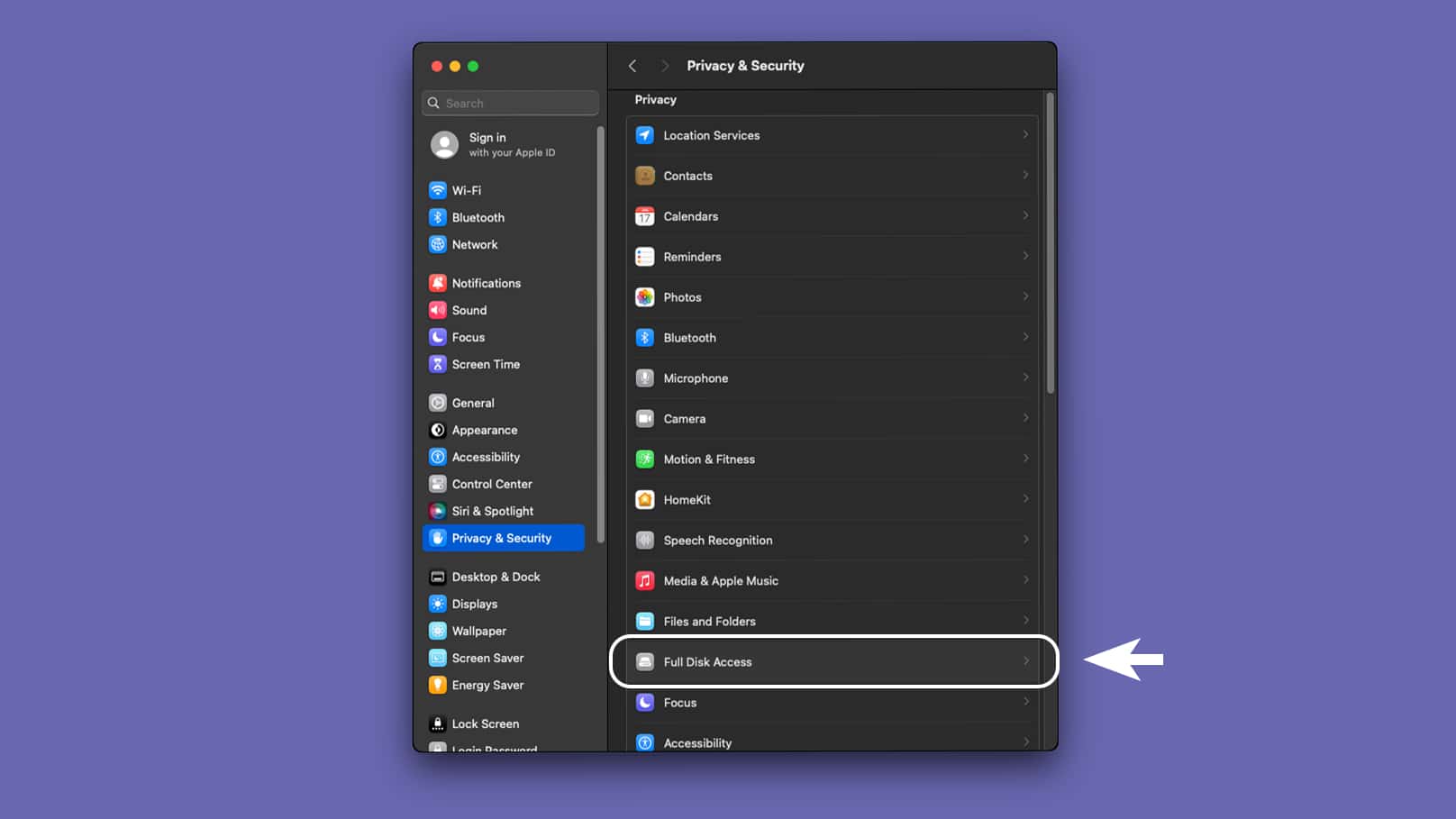
In System Settings, navigate to "Privacy & Security", and locate the "Full Disk Access".
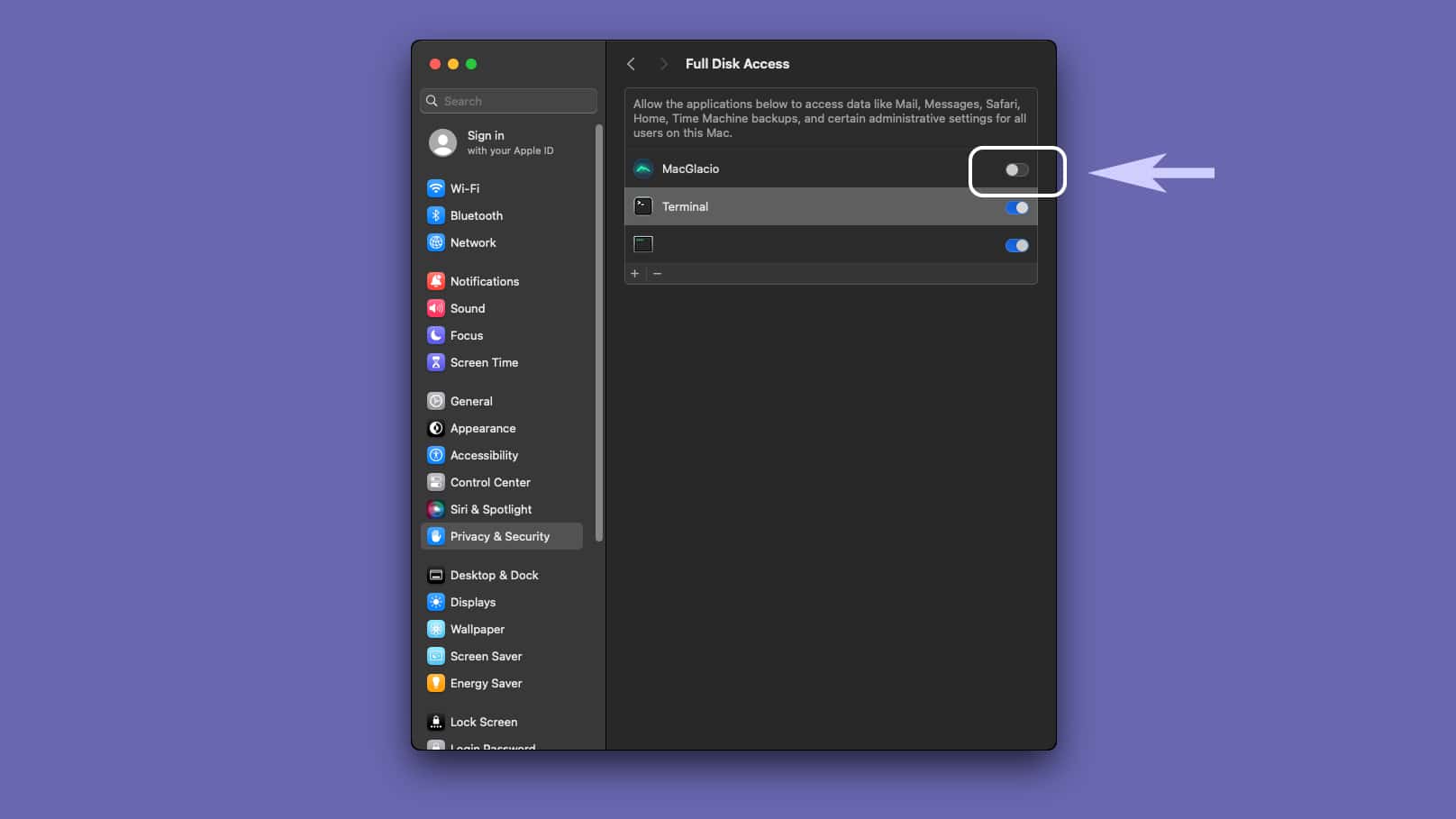
Locate MacGlacio in the list.
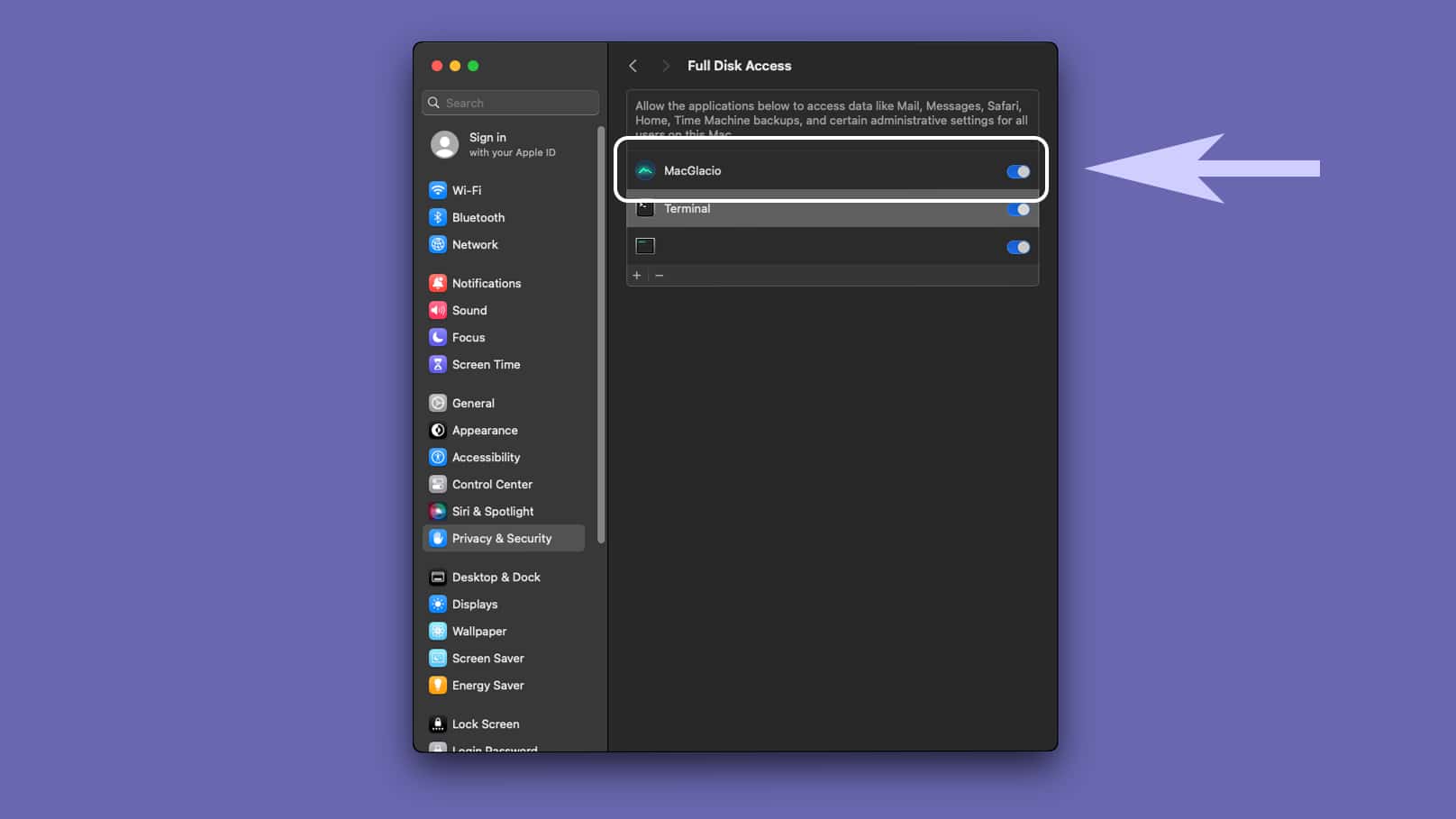
Click on the toggle to activate it.
Issue 4: MacGlacio prompts for "Local networks" access.
Resolution: On macOS 15+ (starting with Sequoia), MacGlacio requires this permission as part of its underlying technical architecture. The software runs on a two-component system, which involves creating a local server to allow the MacGlacio user interface to communicate with the program itself. This step is essential for proper functionality; without it, the software will not work as intended. Therefore, if prompted to grant MacGlacio access to the local network, please click the "Allow" button to continue.
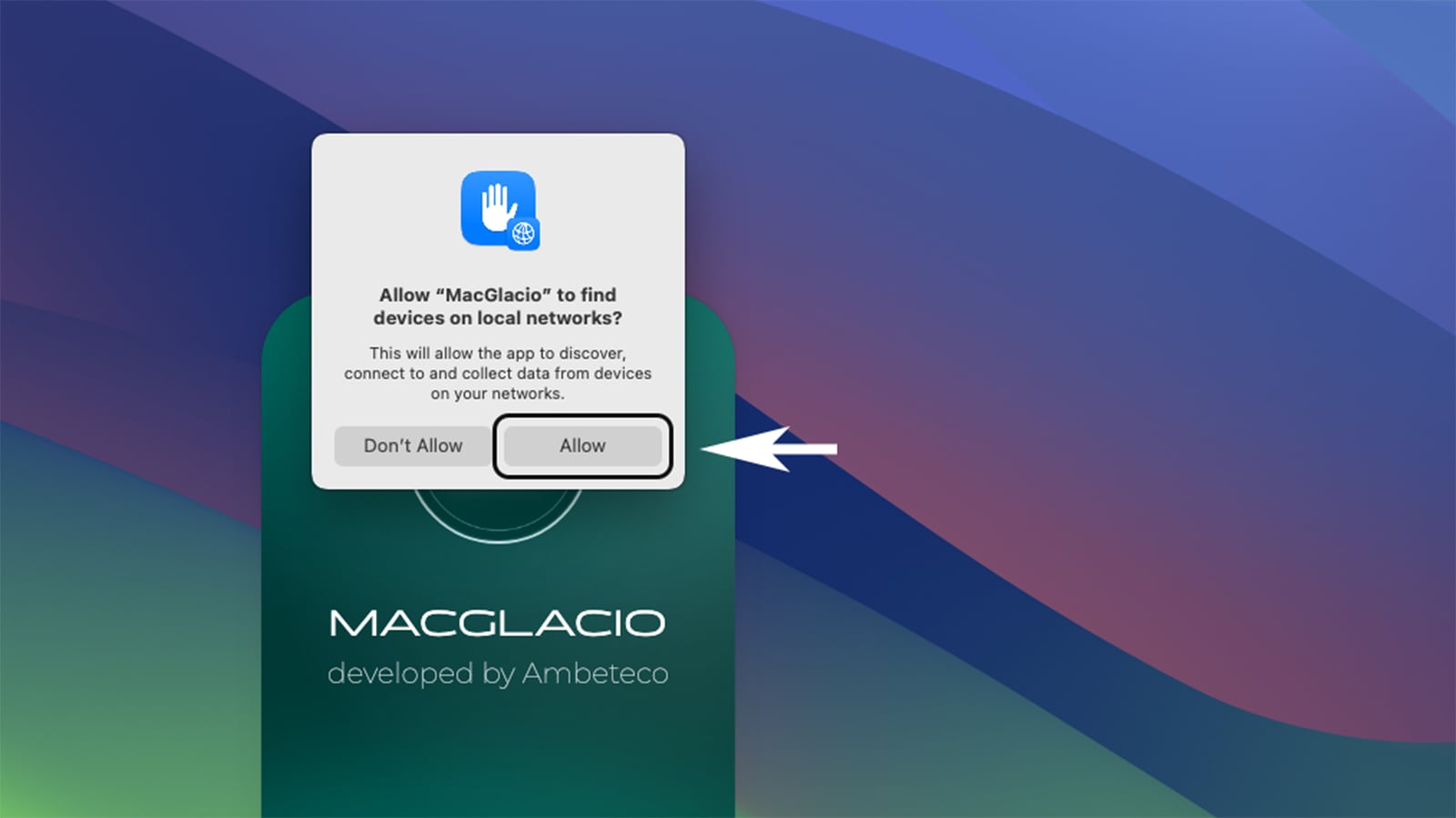
Click on the "Allow" button to proceed.
› Conclusion
MacGlacio is a powerful file-shredding software that can help you securely erase files, making them completely unrecoverable. This Quick Start Guide has outlined all the essential features and settings you need to know to get started with the program. Visit the Ambeteco Product Center for more information about MacGlacio and other guides. Please feel free to reach out to us at any time if you have questions about our software.




